Julia Blosser
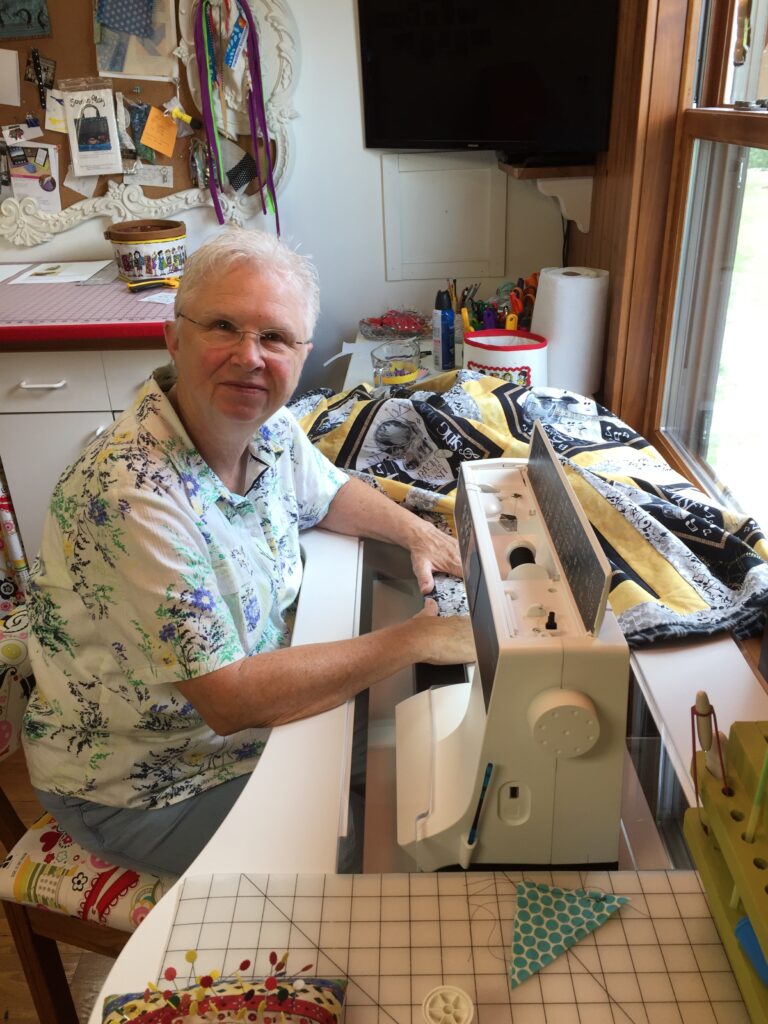
These quilts were all made by Marie Webster Quilt Guild member Julia Blosser.
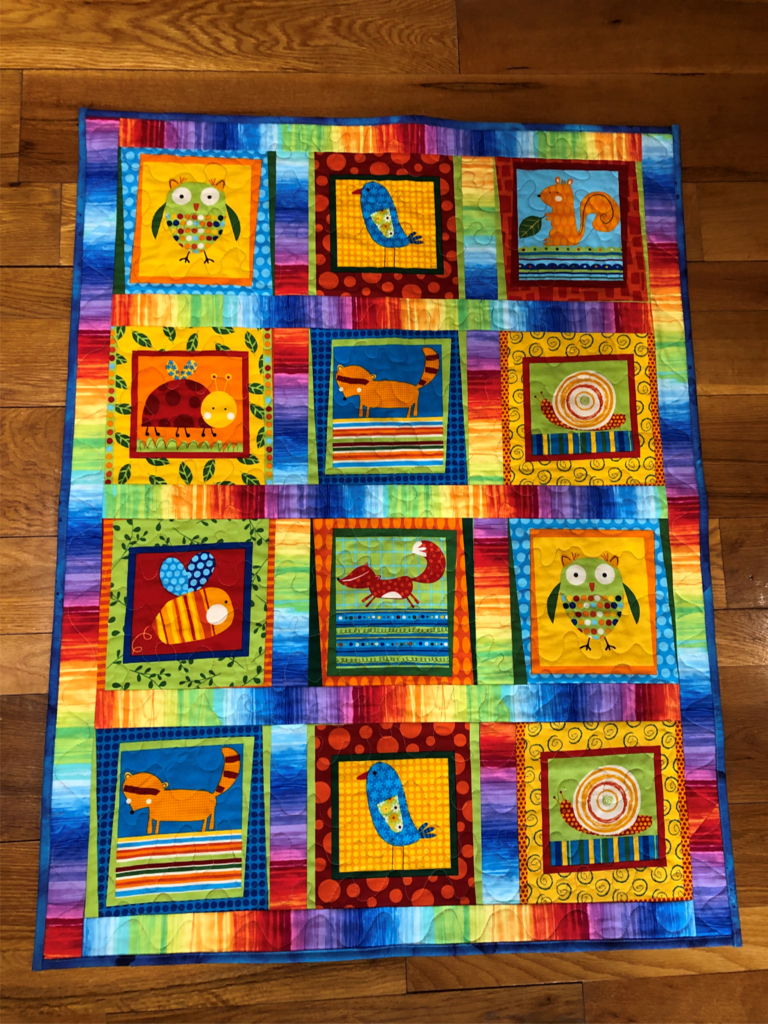
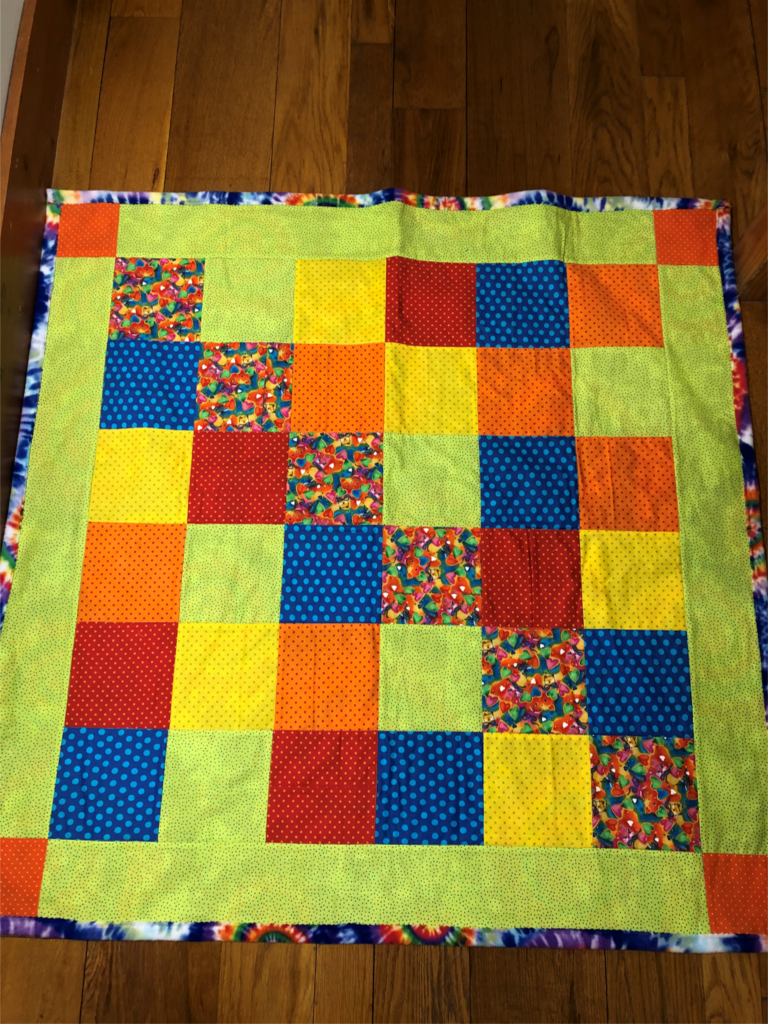
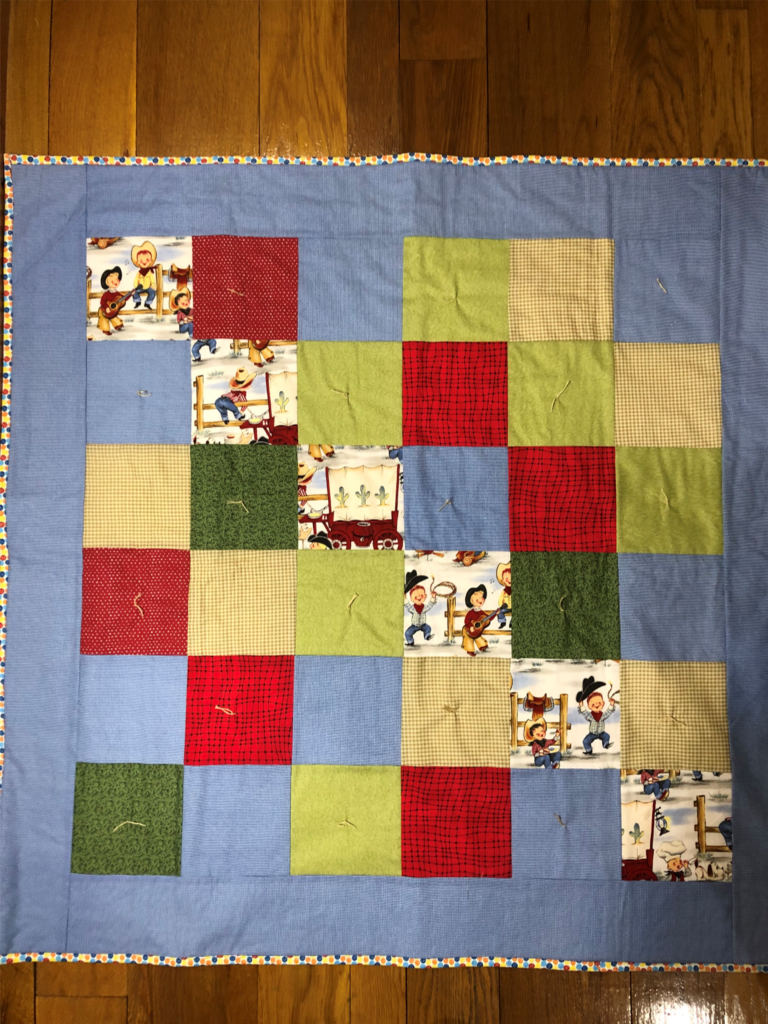
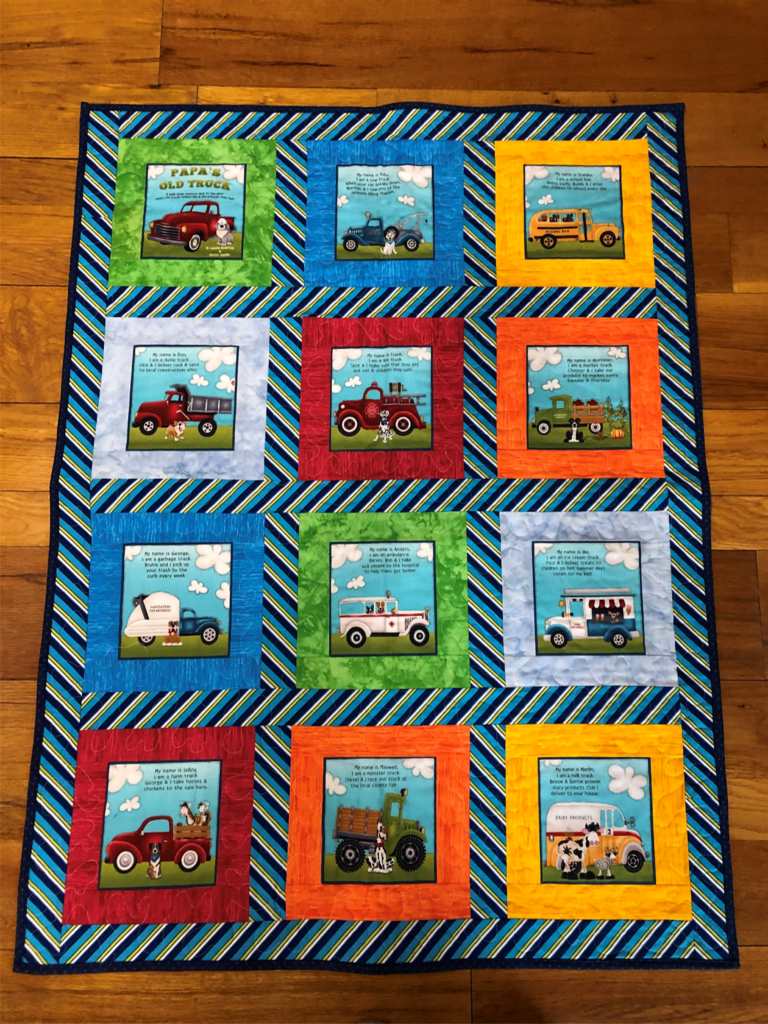

These quilts were all made by Marie Webster Quilt Guild member Julia Blosser.




Last week I wrote about the 50th Anniversary of the Whitney Museum Abstract Art quilt exhibit. Little did I know that I would find (or create in my own mind) a link between the quilts in that exhibit and today’s honoree, Ruth E. Finley.
You may-and if you’re a quilt historian, you should- know Ruth Finley as the author of the second comprehensive book on US quilt history. (The first, of course, being Marie Webster’s Quilts: Their Story and How to Make Them.) You can read some basic bio information about Ruth at the link below.
In 1929, Finley published Old Patchwork Quilts and the Women Who Made Them. She traced the development of quilting from Colonial times, often in a romanticized way, and included stories from her family and other quilters to demonstrate her points. Some of her history has been debunked, as noted in these quotes from the International Quilt Museum website:
Essentially, the “scrap bag” myth goes like this: colonial women needed something to keep their family warm, so they recycled scraps of fabric into bedcoverings, creating a utilitarian object from otherwise useless bits and pieces. During this time progressive-thinking Americans applied Darwin’s theory of evolution to anything and everything, including quilts. In Old Patchwork Quilts (1929), Ruth Finley speculated that quilts evolved from chaos into order, with necessity-driven scrap quilts serving as the first step. Finley did not base her theory on existing quilts; she and other early 20th-century quilt enthusiasts assumed that because examples of such colonial-era scrap quilts did not exist, they had been used up.
Research in women’s diaries and household inventories has shown that women shared textile work. Work parties of the period included barn raisings, harvestings, and huskings in addition to quilt parties. Ruth Finley romanticized quilting bees. The myth transitioned the focus of quilting parties from work-centric to social. The myth turned the quilting bee into a match-making party, an opportunity for young men and women to meet in acceptable social settings after having spent the day working.
OK; so there is a good bit of speculation, extrapolation and even fabrication in Finley’s book. But, as Barbara Brackman notes in her Introduction to the third edition of Old Patchwork Quilts, at the time she was writing, Finley didn’t have access to all the academic writing we have today—she only had one book as a guide (Marie Webster’s book published in 1915).
Old Patchwork Quilts included an attempt to record patterns and names, to describe fabrics, dyes, and quilting techniques, and to put all of this in an historical context. History was important to Finley; the whole family seems to share this interest and they maintain family artifacts and letters dating to the late 1700s. The house Finley grew up in is still in the distaff side, passed to a descendant of her sister, Mary.
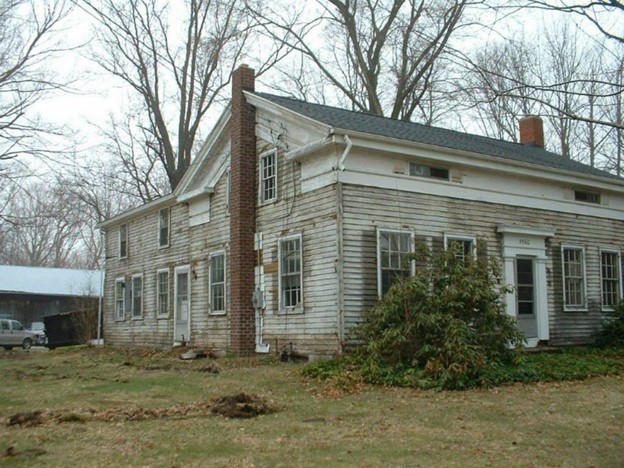
You can read more about Finley’s Colonial Connecticut connections and how she incorporated family legends into Old Patchwork Quilts at the link below to an article by Ricky Clark.
Finley concluded her tome with the sad observation that while women had advanced socially and economically since Colonial days, they did so at the expense of the handiwork into which they had poured their hearts, and that quiltmaking was a dying art.
Boy! Was she wrong on that last count! And she may have recognized, by the time she finished the 16 years of research and writing that went into the book, that the tide was turning back. Here’s what she said in her foreward:
My purpose in writing this book has been twofold: First, to make a record, with the hope that it might prove definitive, of one of the most picturesque of all American folk arts; secondly, to interpret that art in relation to the life of the times during which it most widely flourished. This purpose was itself prompted by the lately renewed interest in patchwork, both old and new–an interest enthusiastically active at the moment and rapidly growing.
Maybe Old Patchwork Quilts even contributed to the revival of quilting in the 1930s and 40s.
So you ask, what’s the connection to the Whitney exhibit? Graphics; quilts as art. Finley herself collected quilts, and many of the plates in her book are from her own collection. In this sample of photos taken from Old Patchwork Quilt you can see the powerful lines of abstract art.
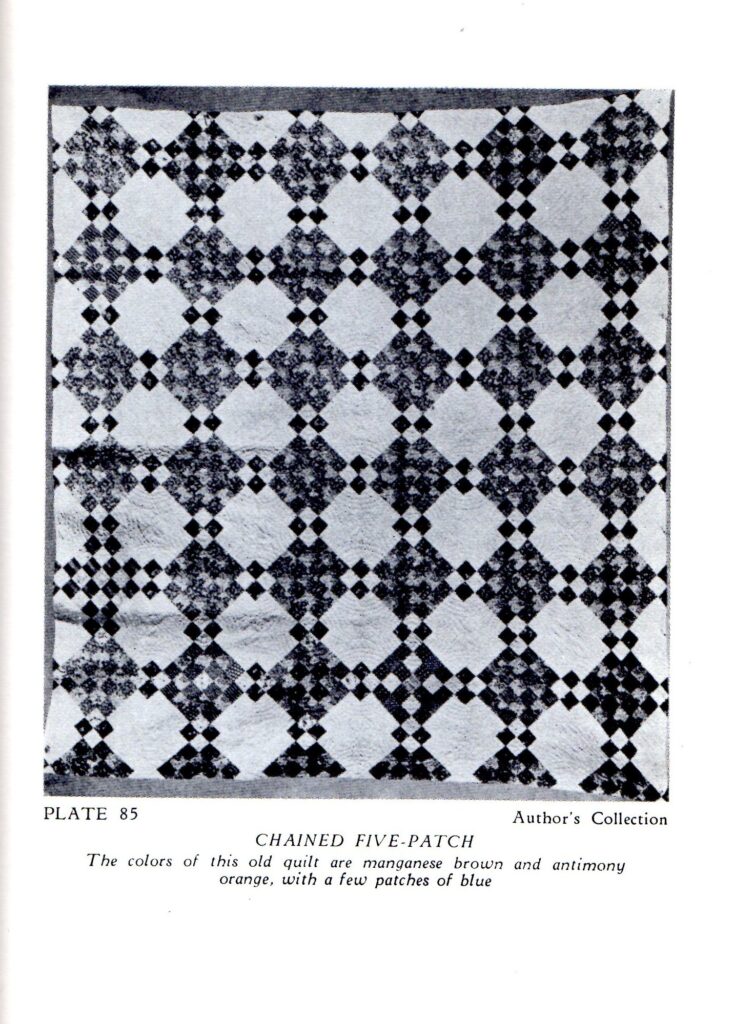
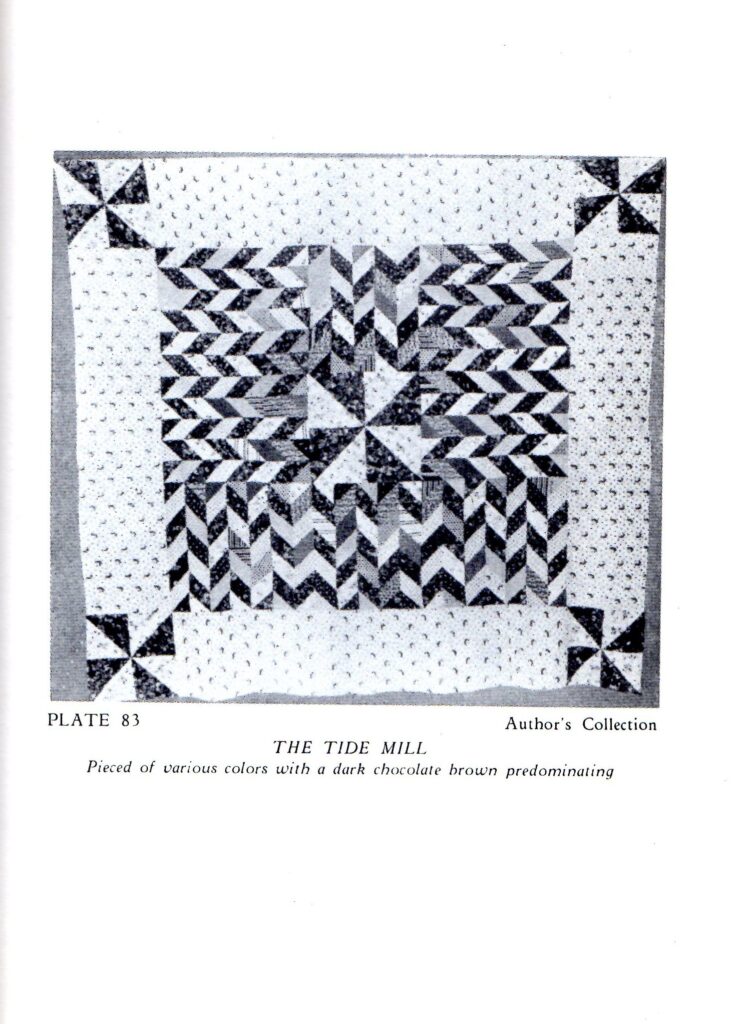
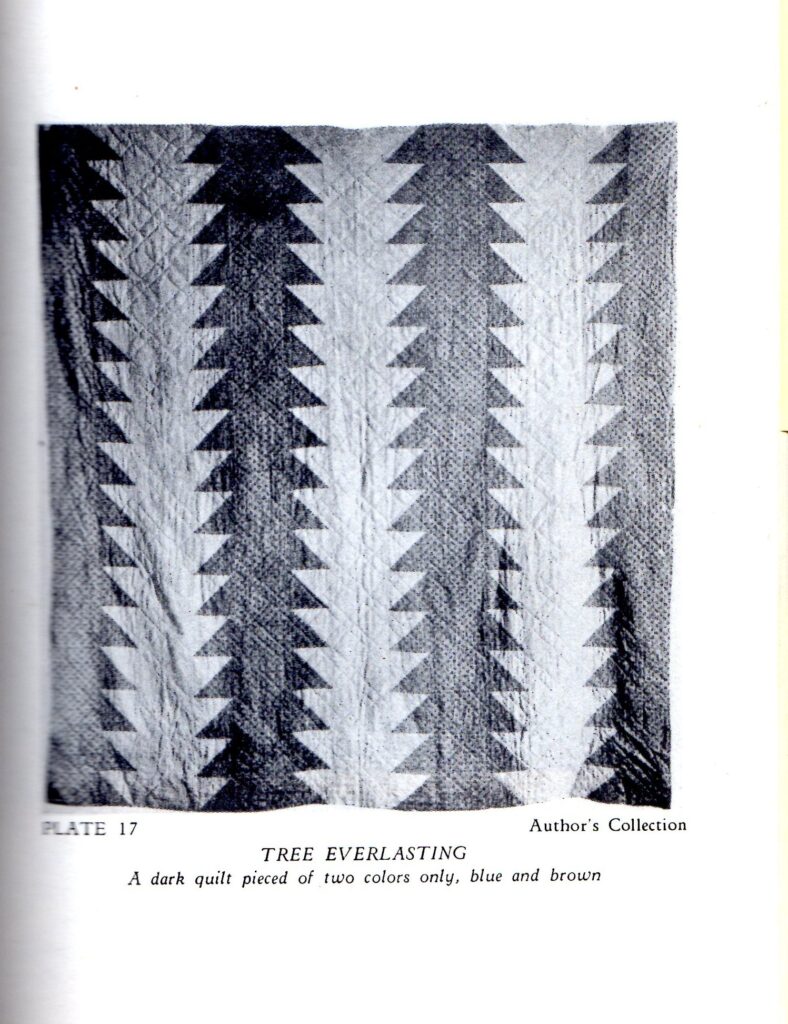
And Finley herself almost predicted the theme of the Whitney exhibit. She wrote,
“Incidentally, this pattern (Hosanna) particularly emphasizes the fact that most quilts are, as one would say today, futuristic—in both color and form. More than one old quilt, like the “Indian Hatchet’, ’Tree Everlasting’, and …. are prophetic of the latest trend in domestic design as to be quite startling. Or would it be heresy to suggest that modernistic art is reminiscent of folk-crafts the creations of which have gone so completely out of memory as to seem now strikingly novel?”
Finley’s collection also included appliqué and non-geometric quilts. One of the most famous to pass through her hands was this one:
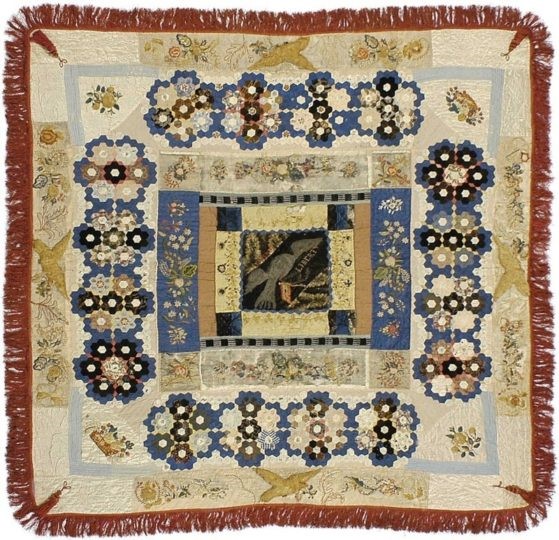
She also designed a quilt, “The Roosevelt Rose”. Finley, although considered a feminist and supporter of women’s labor and education reform, is said to have been a life-long Republican although her parents were Democrats and hosted McKinley in their home, where Ruth presented him with a small bouquet and a little speech. Who knows? Concerning the quilt, she told reporters that it was the first quilt pattern named for a President since Lincoln. (What about Garfield’s Monument? A piece of Ohio history she should have been familiar with.) She also mused that the 19th century fashion of naming blocks for historical events hadn’t produced a 20th century block named “Fourteen Points for Peace”. Here’s “The Roosevelt Rose”.
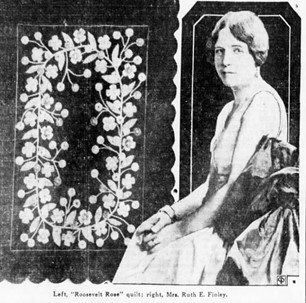
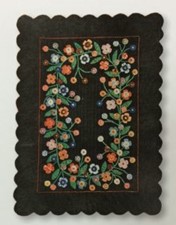
When Old Patchwork Quilts came out, it was publicized all over the country. Finley’s husband, Emmett, who headed the Associated Press wire service, was probably responsible for such wide-spread coverage. The promos were especially popular when they could be treated with “poetic license” to fit an editor’s needs, as seen in these two opportunistic articles. Finley herself never associated “Pine Tree” with Christmas, and she described the second quilt as a bride’s quilt named “Lotus Flower.” But the holiday connections sold newspapers.
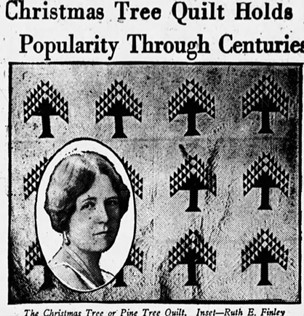
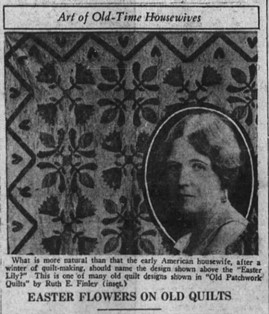
Ah! Newspapers! As important as we think Old Patchwork Quilts may be, that wasn’t what got Ruth Finley into Who’s Who in America; her career in journalism did that. She started at the Akron Beacon Journal where, notably, she scored an interview with the former Akronite wife of Thomas Edison and earned her first by-line by interviewing Mrs. Henry Ford. Her career took off when she moved to the Cleveland Press and did a series of articles on the condition of working women. These articles were syndicated and published throughout the US.
Following in the tradition of the undercover work of Nellie Bly (who stayed 10 days in an asylum for an exposé), and the muckraking tactics of Ida Tarbell, Finley assumed the persona of a working girl, Ann Addams. She worked in a restaurant (a week), laundry, mill, sewing shop, factory; was “insulted in a mansion”. Once again, the editors took liberties and made it seem that “Ann” was on assignment to them; here’s a headline from Wilkes-Barre, PA; similar headlines appeared in Oklahoma, Washington, and Indiana.

And here are the accompanying syndicated photos for “Ann’s” jobs:
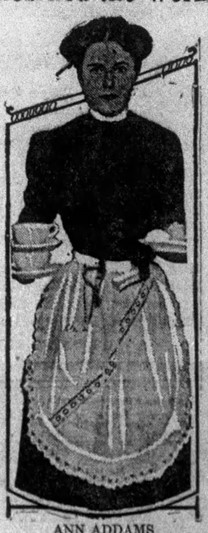
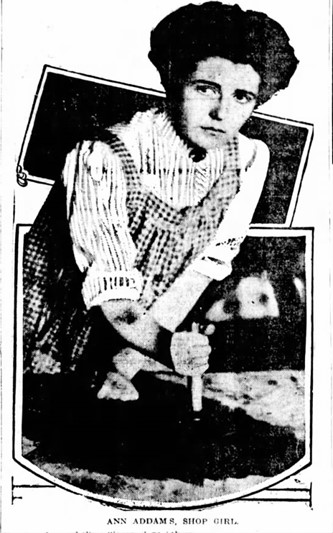
In the shop girl story, “Addams” exposes the issue of piece work, favoritism, and unwanted advances.
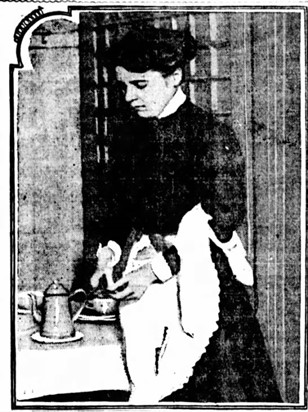

In this article, pretty little Emily, sick from food poisoning through a meal that was part of her wages, is “holding her fort like a wounded soldier” until she collapses and is taken out back and left while the other waitresses had to continue to push through the lunch rush.
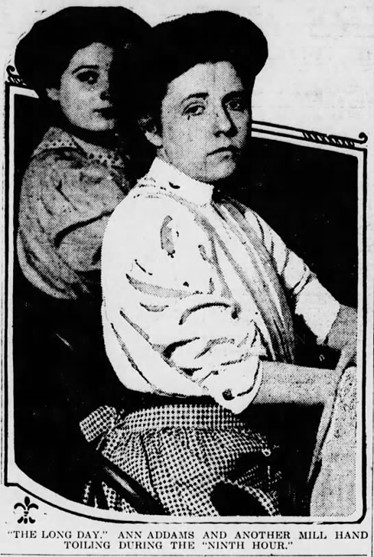

Here, “Addams” tells about metal cuts on the working girls’ hands and the cost of “prosperity” at the expense of the working girls who are forced to put in extra hours.
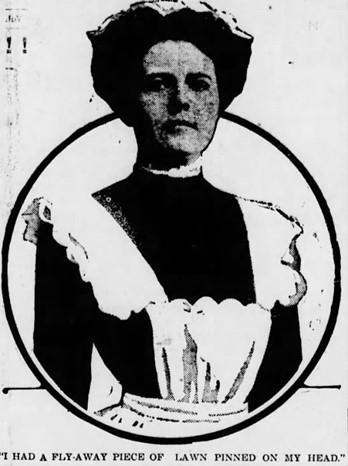

“There was a peculiar interest attached to being literally cast into the streets of a strange city, sick, friendless, and with only $2.36 in my pocket by a woman who posed before her clubs as a humanitarian and philanthropist with special concerns of in the welfare of working girls.” In this story, the mistress won’t let “Ann” wear a coat to do front porch work and terminates her when she shows signs of pneumonia (but says she will welcome back such a good worker if she isn’t sick.)
And this is where the “insult” comes in. “Ann” describes in the article how she pleaded with the mistress that she had no place to go. After suggesting she go to the YWCA but refusing to tell “Ann” where it was, the following colloquy ensues:
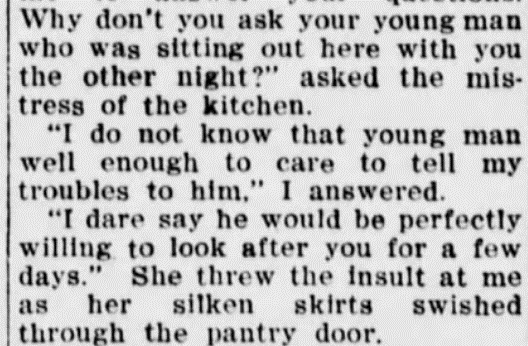
If it’s true that “Ann” only had one male visitor during her tenure, there may be a little backstory here, as related on Karen Alexander’s blog
“It was while working as a housemaid on an undercover story about working conditions for lower-income women that she met her future husband, also a journalist. Ruth feared her “missus” was getting suspicious because all her previous maids had had a “young man” calling on them and Ruth wanted to distract her from any questioning, so she asked the boss to send someone over. The boss chose Robert Finley, though not without some protest on Finley’s part. Within a few months the serendipitous meeting ended in a marriage with her boss taking credit in print in the newspaper for bringing them together!”
Finley’s journalistic career wasn’t all so sensational. She was woman’s page editor of the Cleveland Press, fiction editor of the Scripps-Howard newspaper chain, managing editor for the old Washington Herald, woman’s editor of the Enterprise Newspaper Association, assistant editor of McClure’s magazine and editor of Guide Magazine and the Woman’s National Political Review. She also wrote about Sarah Josepha Hale, the editor of “Godey’s Ladies Book” (who must have been something of a hero for Finley in her crusading aspect and a role model in her professional one—Finley thought someone should have designed a quilt block named for Hale). And no discussion of Ruth Finley is complete without telling that she and her husband were occultists and wrote under the pen name “Darby and Joan” about their spiritualistic encounters with a World War I soldier. What a varied career!
I hope you enjoyed reading a little about Ruth Finley.
Your quilting friend,
Anna
Bio info. https://quiltershalloffame.net/ruth-finley/
Ricky Clark, “Ruth Finley and the Colonial Revival Era”. https://quiltindex.org/view/?type=page&kid=35-90-191
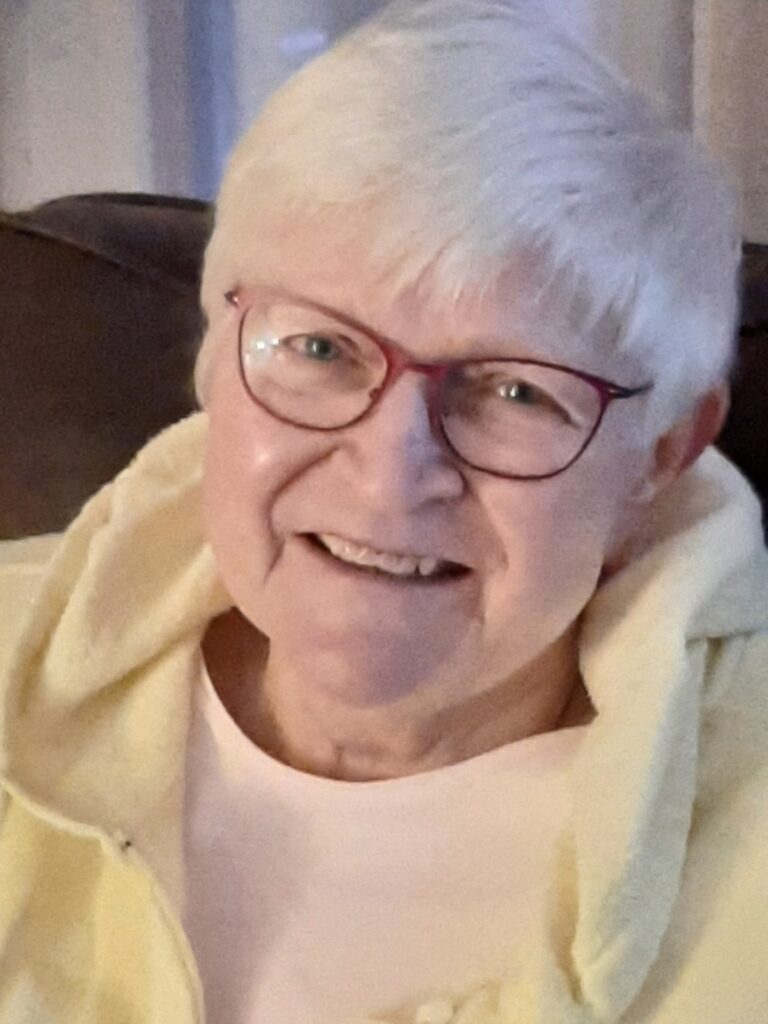
These quilts were all made by Marie Webster Quilt Guild member Jocelyn Smith.
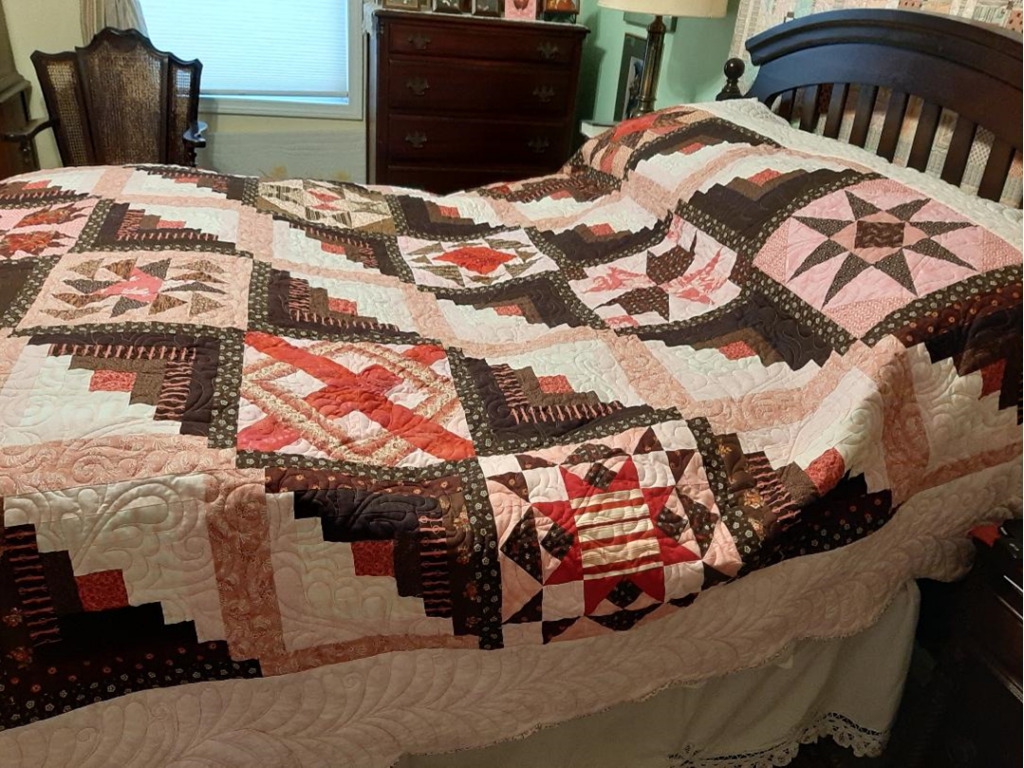
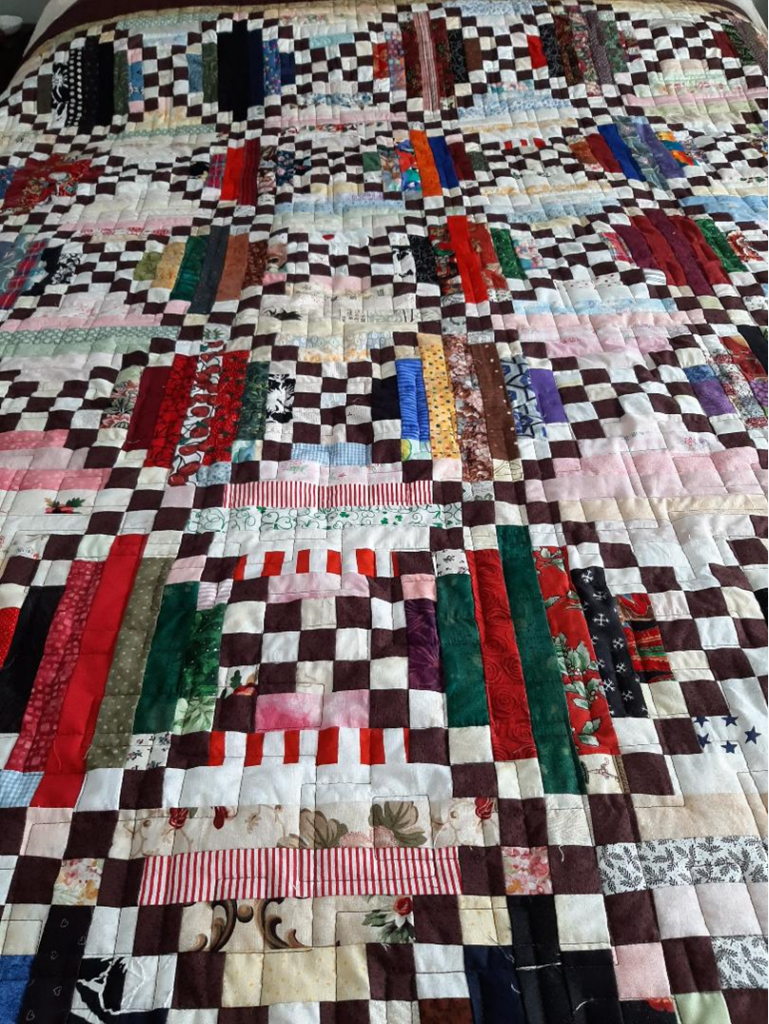
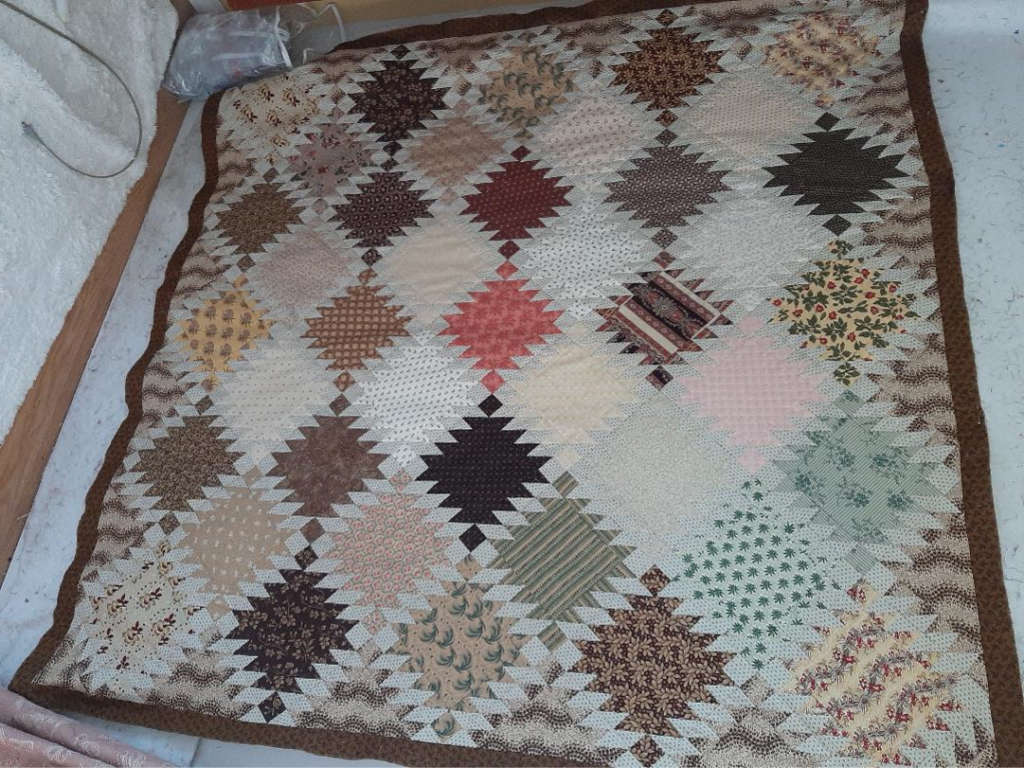
Happy 50th Anniversary to the Abstract Design in American Quilts, at New York City’s Whitney Museum of American Art mounted in 1971 by our Honorees, Gail van der Hoof and Jonathan Holstein. If you want a review of these two quilt pioneers and their impact on the quilt world, check the links below. In the meantime, let’s figure out how to mark this milestone, because
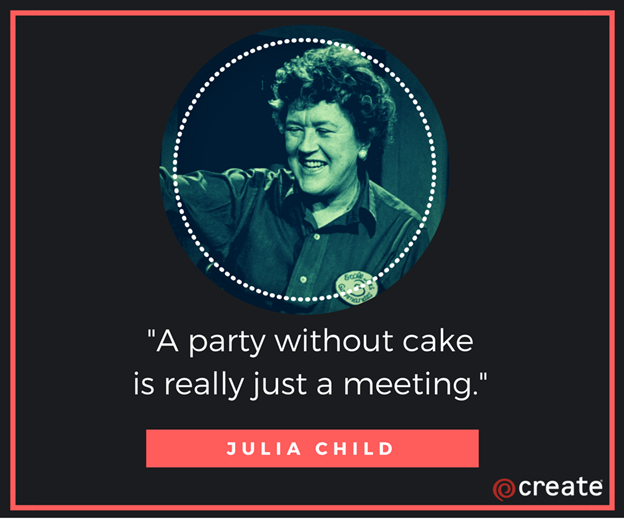
Ok; no cake, but let’s at least celebrate. The International Quilt Museum in Lincoln is celebrating by offering several related exhibits over the course of the year. In addition to a retrospective and an update, one will show how the original display fared in Japan, and another will focus on the New York connection (I didn’t know there was one, so I’ll be interested to see how they pull that together). There’s not much on the IQM website right now—they don’t put up pictures until everything is finalized because the plan for the featured quilts might change. There’s a link below, and you’ll have to keep checking for dates and details. IQM has done such a great job this year with their virtual offerings that I’m sure it will be worth the wait to see what they come up with on this.
So, how else can we party? Would you be up for a challenge to make a Whitney-worthy quilt this year? The original exhibit focused on traditional quilts, but showcased their qualities as abstract art. Most were graphic, some (especially the crazy quilts) were akin to Pollack paintings, others were included for their striking use of color. This is really up my alley. I’ve told you in the past how much I admire quilters like Honoree Carolyn Mazloomi whose quilts tell a story, and I love the SAQA-style quilts. But those genres aren’t in my wheelhouse; I do geometry. Now all I have to do is geometry plus art.
You can do this too; in fact, you’re probably already doing it. So, why not make it into an homage to the Whitney Abstract Art exhibit with this challenge? If you want to participate, make any quilt that you think reflects the theme of the 1971 exhibit, that is, quilting as an artistic medium. Send a photo to our Executive Director, Deb Geyer admin@quiltershalloffame.net with your name and a statement (50 words max, please) about the artistic quality of your quilt. We’ll post you photo on our Facebook page (by sending it to us, you give permission for this use).
I’ll start out with a quilt that is currently on one of the beds at my house. I think it’s “abstract art” because it’s graphic and shows interesting variation in the different blacks. See how easy that was? Send your entry; think of it as bringing a gift to the anniversary party.
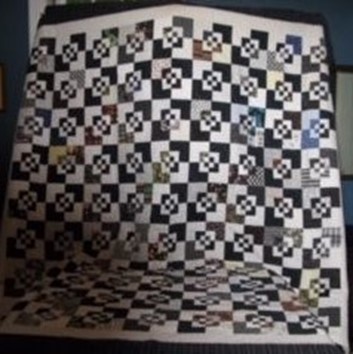
And now for something completely different. (Quoting Monty Python here; I have these remnants of my mis-spent youth rattling around in my head.)
It’s been snowy in the Chicago suburbs, but that didn’t stop my Bee from “going” on a retreat (virtually). All of us are COVID risks, so we haven’t been able to/willing to get together in person since last September; many of you are probably in the same boat. Here’s what we did: we set up Zoom meetings for the days we would be gone if we could actually go to a retreat location. We checked in on Friday night, three times on Saturday, and twice on Sunday. We had a small “joint” project to work on– everyone made three red, white, and blue 12” blocks in the pattern of her choice, to be assembled later as a quilt for our local veterans’ shelter. Here are mine. I learned that I should never attempt paper piecing with directional fabric; each block took three times as long as it should have.
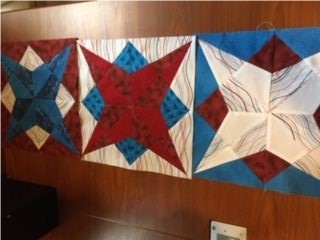
We had also decided on a block of the month project with each of us working in our own colorway, but the fabric hadn’t come by “retreat” time, so that left us free to do whatever else we wanted. Several gals chose to finish UFOs that had been hanging around. One member made a baby quilt from start to finish (she won the “Smokin’ Needle” Award). I started some new things, including a non-directional paper piecing table runner and these ornaments made from Christmas fabric selvages.
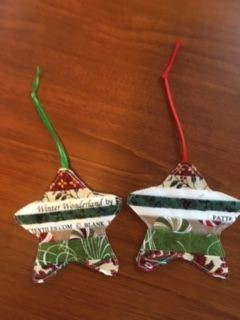
I was able to set up my computer next to my sewing machine and ironing board, so when we checked in on our Zoom calls, I could keep working. It was almost like being together with everyone, and it made the work of sewing & pressing 143 blocks for my Falling Charms quilt less tedious. Our conversation ranged from quilt tips (where to get numbered pins, etc.) to family updates, to guild matters, to favorite quilt books and magazines. And of course, lots of encouragement as we showed our progress.
I added a few extras for myself to make it seem more like a retreat. First, I cut my big project ahead of time. Then I packed all my projects in my rolling crate and restricted myself to working on what I had “brought”. (Don’t you always get to retreat and find you’ve left something at home? This time I packed really well.) I also packed a small overnight bag with my clothes for the weekend and my “wear-in-public” pajamas. Jack got curbside pickup for dinner on Friday and Saturday, and I pre-made lunches so I wouldn’t have to cook. Oh, and prior to the retreat, I went shopping online and at our local quilt shop; we always shop hop at all the stores between here and the retreat house. One of my Bee mates made fun of me for this, but I think it really helped me to separate this weekend from my ordinary sewing day, and made me feel like this was something special.
Let me know what you are doing to stay sane and keep in touch with the quilt world while you can’t get out. I hope someone out there is collecting information about how quilters are coping with the pandemic; this will be a big part of quilt history.
Your quilting friend,
Anna
PS I just learned that some of you are commenting on Facebook when TQHF posts my blog. I didn’t know to look there, so I have probably missed giving a response to many of you. But now that I know it’s there, I’ll watch and reply.
Bio info: Holstein https://quiltershalloffame.net/jonathan-holstein/ ; van der Hoof https://quiltershalloffame.net/gail-van-der-hoof/
Blog entries: Holstein 0902 https://quiltershalloffame.net/jonathan-holstein-quilts-from-the-bed-to-the-wall/ ; van der Hoof 0512 https://quiltershalloffame.net/whats-it-like-to-have-a-career-in-textiles-ask-gail-van-der-hoof/
IQM exhibits https://www.internationalquiltmuseum.org/exhibitions/upcoming-exhibitions
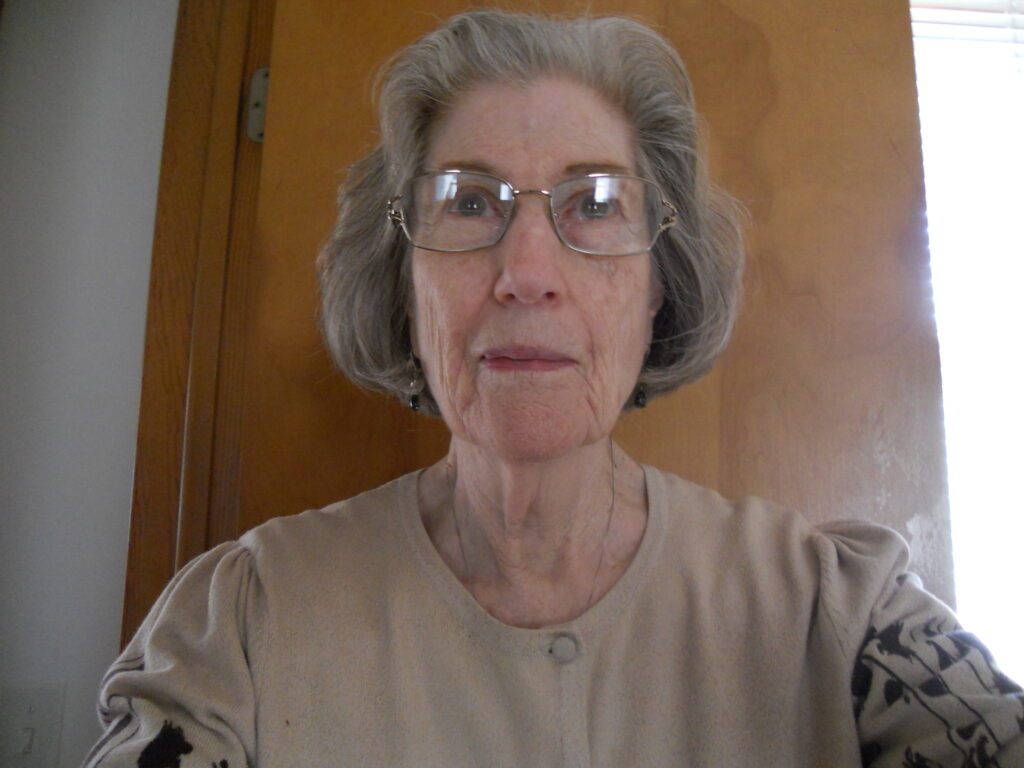
These quilts were all made by Marie Webster Quilt Guild member Phebe Smith. Phebe is one of the founding members of the guild.
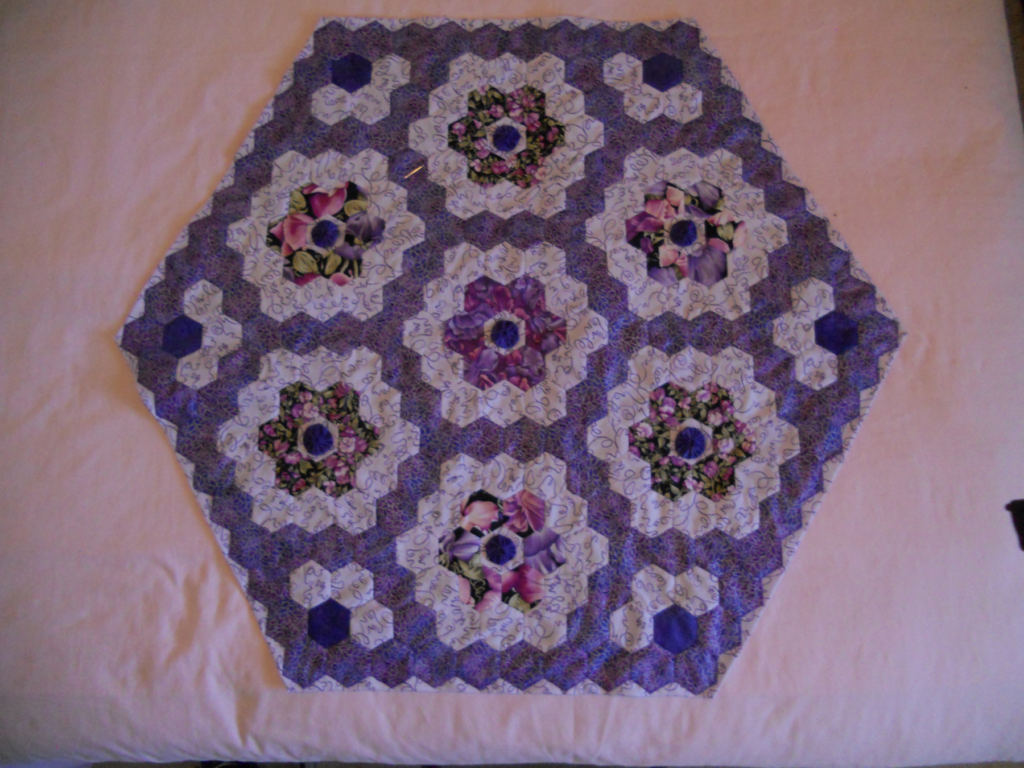
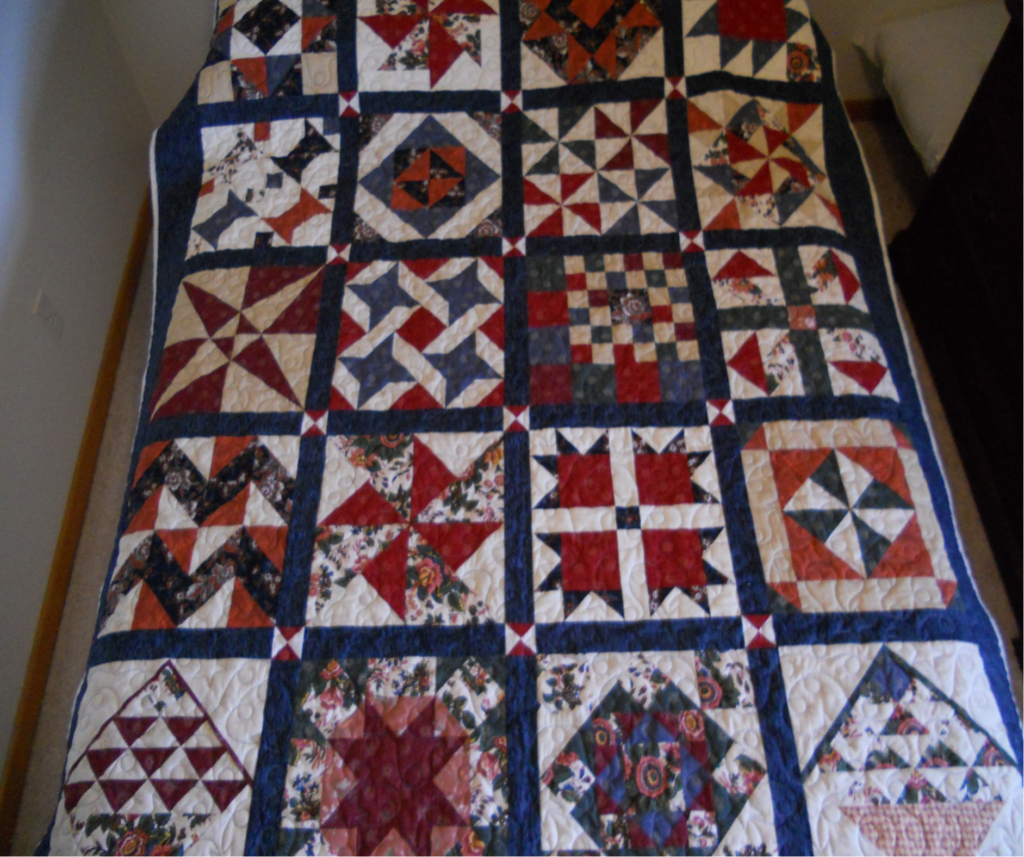
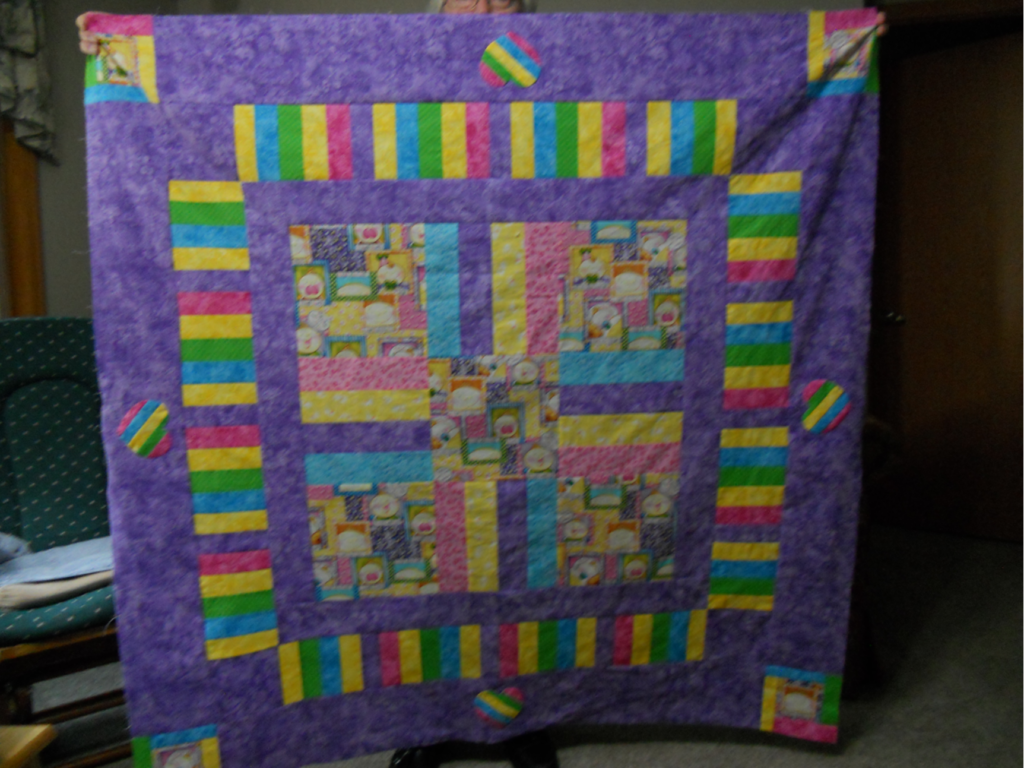
I don’t know about you, but January is a time for me to draw in, reflect, and simplify. This has become especially true this year since the pandemic is still limiting my social life and activities. So, I’ve been thinking about quilting in the days before we had so many gadgets and tools, and that led me to Honoree Georgia Bonesteel.
Georgia’s quilting career spanned the time when TV shows and video tutorials were the rage. (Now we just go to the internet.) She started with crazy quilt handbags as a guest star on Sewing is Fun, a local New Orleans show, and went on to have her own PBS series in 1976. By 2003, she had made twelve more 13-part series. She really enjoyed combining quilting and teaching. You can read more about Georgia’s life in the bio link below, and you can find many of her segments on YouTube.
I watched the first video she ever made, just to get a sense of her as a person for writing this blog. But guess what? I picked up a few pointers which I’ll be trying on my next big project (Edyta Sitar’s Alaska quilt, which uses templates). You can watch it at the link below. Sometimes it’s good to go back to the basics.
She has also authored a number of books based on her “lap quilting” method: piecing and quilting small sections and then sewing the quilted sections together at the end. It was innovative when she introduced it, and as her last volume says, it still “lives”.
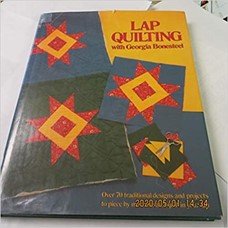

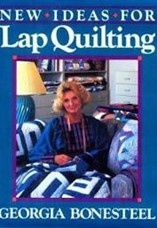
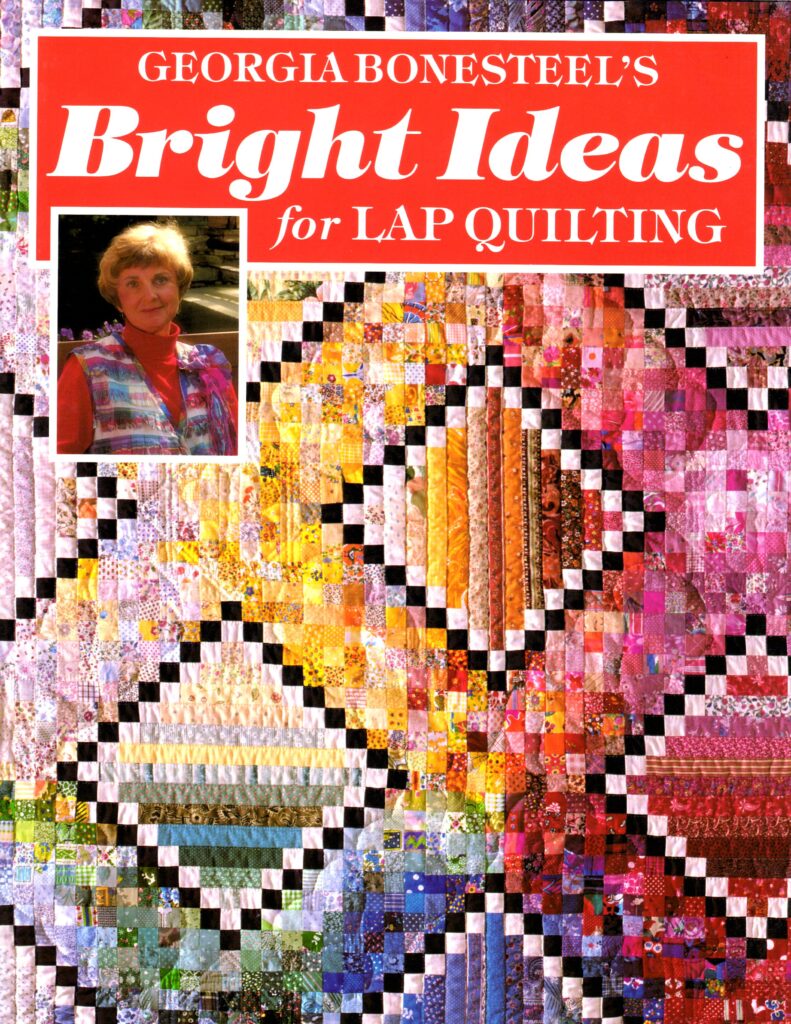
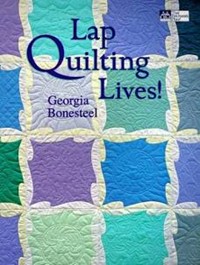
Take a look at the quilt on the cover of “More Lap Quilting” (top row, middle). Here’s the original quilt which is now in the Quilters Hall of Fame Collection. You can view closeups of this quilt and read why Georgia “cherished” it at the link below.
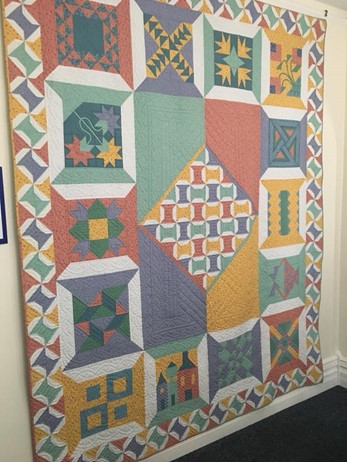
Georgia has been a good friend of the Quilters Hall of Fame, and a regular attendee at our Honoree Celebrations each July. In 2004 her son, Paul, recorded video footage of the grand opening of the Marie Webster House. The following year, Paul turned the video into a film for PBS featuring Georgia’s quilts and telling the story of quilting from Webster forward. It also includes great views of the Hall of Fame, along with an interesting panel discussion among Honorees Barbara Brackman, Joyce Gross, and Cuesta Benberry along with quilt historian Connie Chunn.
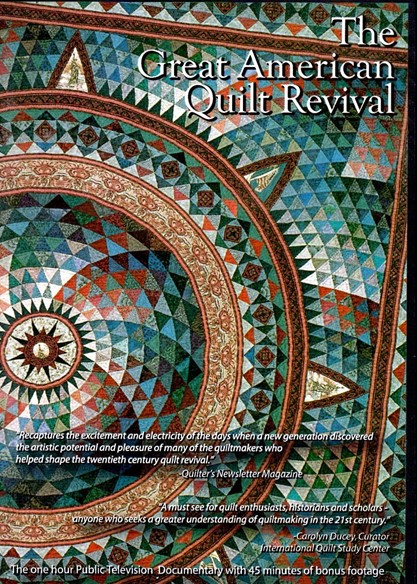
“The Great American Quilt Revival” is sold out in Georgia’s online shop, but it’s still available through The Quilter’s Hall of Fame. Here’s the link to the store: https://shop.quiltershalloffame.net/t/georgia-bonesteel . If you use the code “BONESTEEL” when you order, you’ll get a 20% discount on any one Georgia Bonesteel item. And you might find some other things to purchase while you’re there.
We are also privileged to have several other objects from Georgia in our collection. One of my favorites is a wall hanging titled “Three Banners: The Street Where Quilters Live”. It was made by Georgia and some of the famous quilters she met while producing her TV shows.
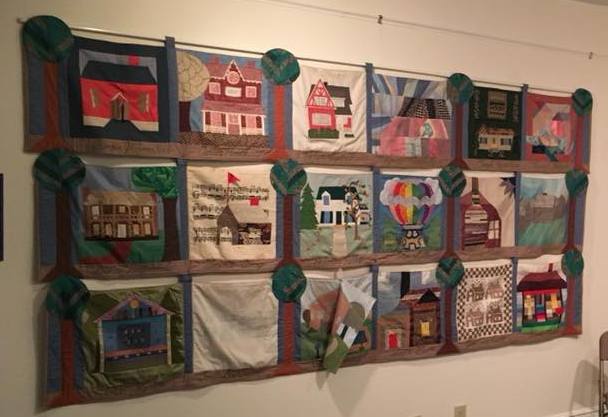
It depicts an imaginary house for each of 36 quilters, most made by the quilter, and three made by Georgia in addition to her own, where she supposed they might live according to their respective quilting styles. I love the fact that she took the time to reflect on their personalities and to put some individual element into each block. For example, you may remember from my April 4, 2020 blog about Virginia Avery that she was not only a quilter, but also a jazz musician. Here’s her block showing “Sunday Jazz at Folly Farm”.
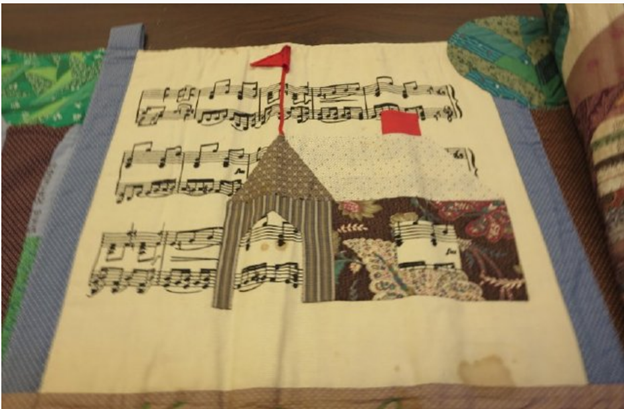
And here’s one that uses the Seminole piecing which Cheryl Bradkin was noted for. There’s a link below if you want to see more of the blocks.
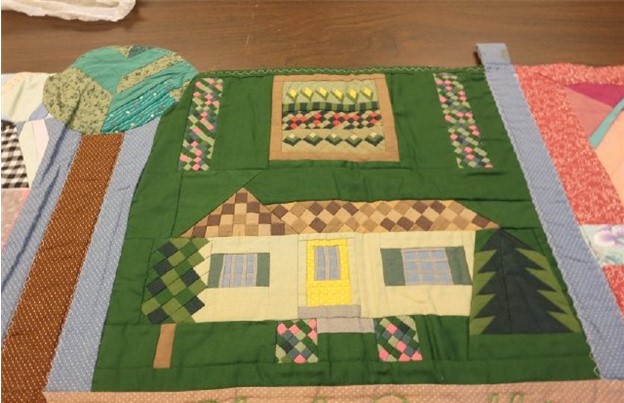
I don’t know whether Georgia Bonesteel was the first to make this kind of album quilt—a step up from “signature”/ name-inscribed quilts that have been around since the 1840s– but she wasn’t the last. Our 2021Quilter’s Hall of Fame Inductee, Marti Michell, assembled a similar quilt representing many quilters (not houses, but each block represents the quilter in some way.) Here’s the block in Marti’s Silver Star Friendship quilt made by Cheryl; it’s the cover of her Seminole piecing book.
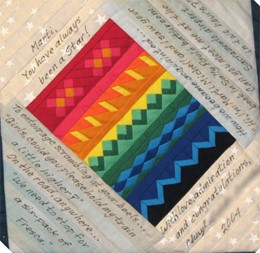
Here’s another example of a Bonesteel group quilt with components made by all of the teachers on a quilting cruise. This one is also in The Quilters Hall of Fame collection. Check the link below to see who the teachers were. I think Doreen Speckman must have made the “Peaky/ Spike” block in the lower right sail; do you agree?
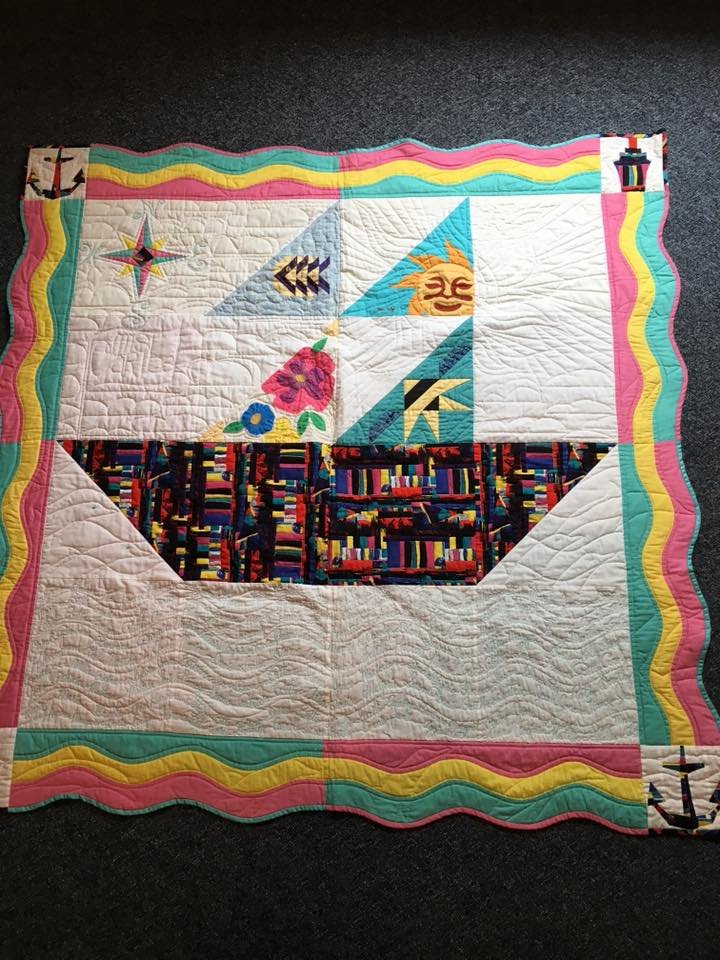
Like many of us, Georgia Bonesteel started sewing clothing for herself and her family. And once she was into quilting, she didn’t forget her garment-making roots. She participated in the Fairfield Fashion shows (see my Jean Wells blog), and donated several items of clothing to The Quilters Hall of Fame collection. She gave a four-piece ensemble comprising a dress, belt, vest, and (yes, you’re seeing that right) cover for her Bernina machine. The title? “Have Machine, Will Travel”.
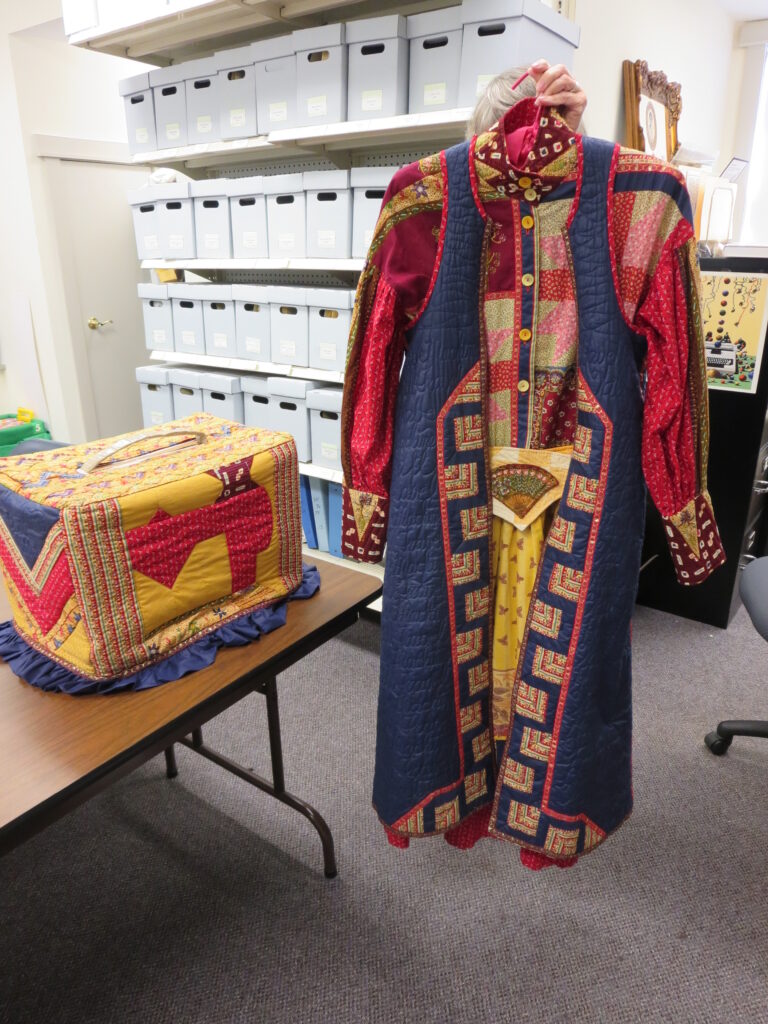
Her gift of the “Harbor Light” group represents the flame of the Statue of Liberty’s torch. And the final item, just identified as “Jacket” is the most sophisticated of the collection. You can read full descriptions and see more pictures at the links below.
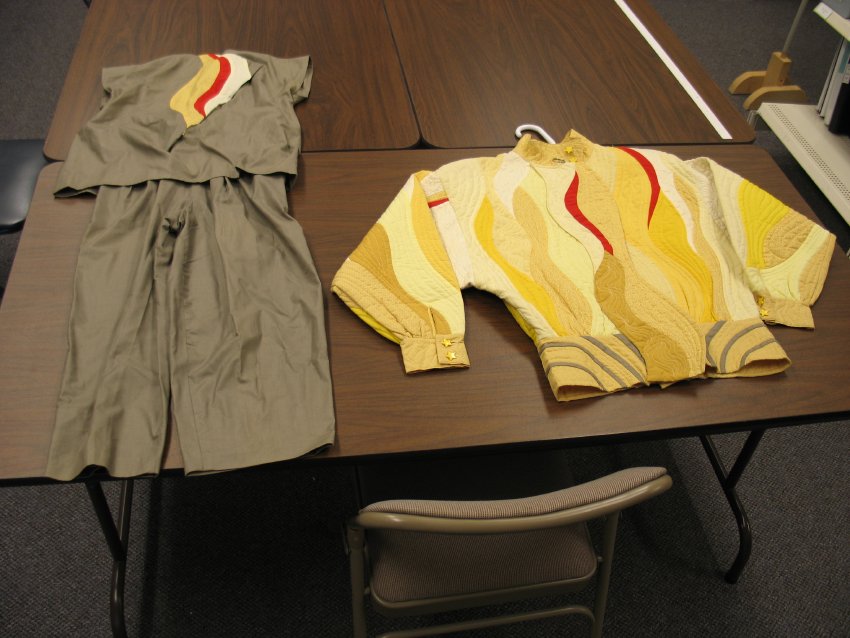
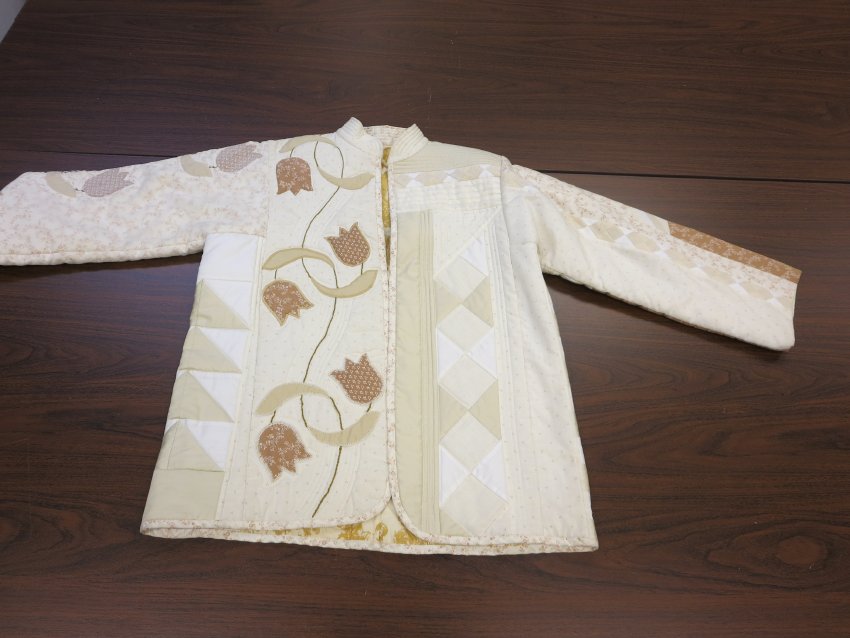
These are the pieces we’ve kept for TQHF’s collection. Our storage space is very limited, so we’ve culled a representative bit and have passed on the rest to The International Quilt Museum in Lincoln.
I’m going to backtrack a little and return to books because Georgia has continued to write. And her more recent ones are often self-revealing. Do you see the bird on the black quilt on the cover of Quiltmaking Legacy? As of 2014, Georgia has kept chickens at her house, and is a member of the Hendersonville Hen Society. And I know the block on the lighter quilt has a different name, but in this context, I can’t help thinking of rooster combs.
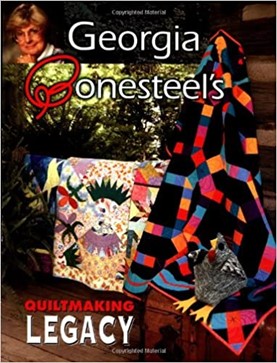
And here’s Georgia’s most recent effort in which she shares family history and gives you a peek at her furniture. I have to admire someone who is so willing to share not only her technical expertise but also her personal information. Quilters are reputed to be giving, but we’d be hard-pressed to find one more generous than her. Thanks, Georgia Bonesteel.
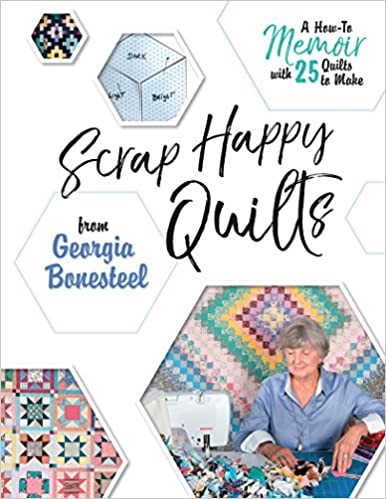
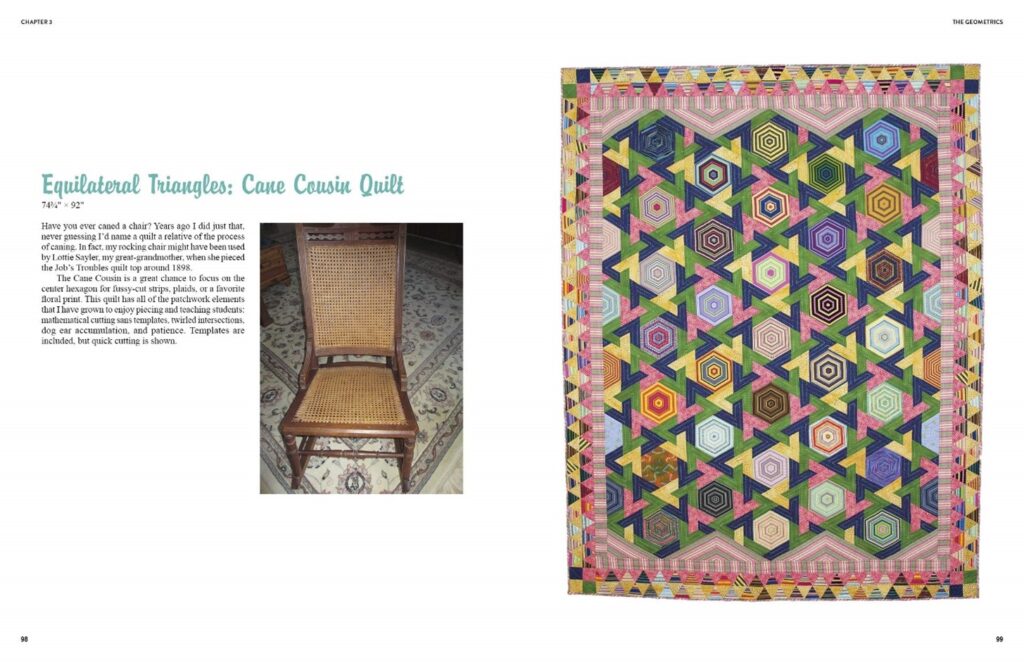
Your quilting friend,
Anna
Bio info. https://quiltershalloffame.net/georgia-bonesteel/
Spinning Spools object record. https://quiltershalloffame.pastperfectonline.com/webobject/B5D7C999-DCCF-4489-970E-698477563951
First video. Georgia said, “This instructional video was produced in 1988 by Oxmoor House publishing and sponsored by Bernina USA. This was the first (and only) VHS video created to teach my “lap quilting” technique outside of the PBS studios of North Carolina Public TV. This video teaches how to make three quilts including the “Carnival” “True Blue” and “Garden Party” quilts.”https://www.youtube.com/watch?v=eeU6in3nHog&feature=share&fbclid=IwAR1S9CJqIRpDdgFI6uPR3MWYPrGUES8qBJDMgFK6SCbdAG4x7FmhW_pdblU
Three Banners quilt. https://quiltershalloffame.pastperfectonline.com/webobject/E48C0E83-5EAD-4499-88AB-576927272073
Cruise quilt object record. https://quiltershalloffame.pastperfectonline.com/webobject/20303541-FA2B-45E7-B27D-992174538019
Have Quilt object records. https://quiltershalloffame.pastperfectonline.com/webobject/98D8B71D-184A-4131-8A48-776420903964
https://quiltershalloffame.pastperfectonline.com/webobject/4A50C663-21CD-4B9F-BA08-789047439802
Harbor Light object records. https://quiltershalloffame.pastperfectonline.com/webobject/15F13018-1830-4B92-B3AE-071817501276
https://quiltershalloffame.pastperfectonline.com/webobject/7FAE53AC-8E3F-4636-9A98-535571281597
Jacket object record. https://quiltershalloffame.pastperfectonline.com/webobject/4A50C663-21CD-4B9F-BA08-789047439802
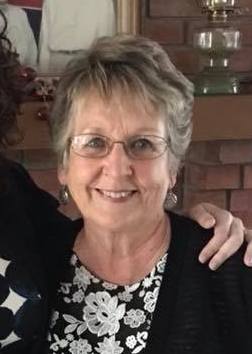
All of these lovely quilts were made by Marie Webster Quilt Guild member Vicky Jones.
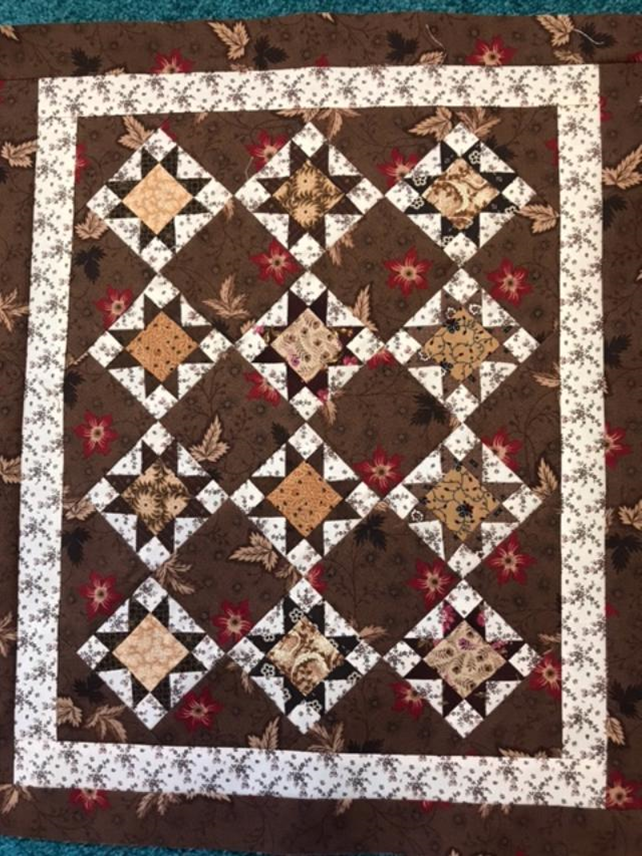
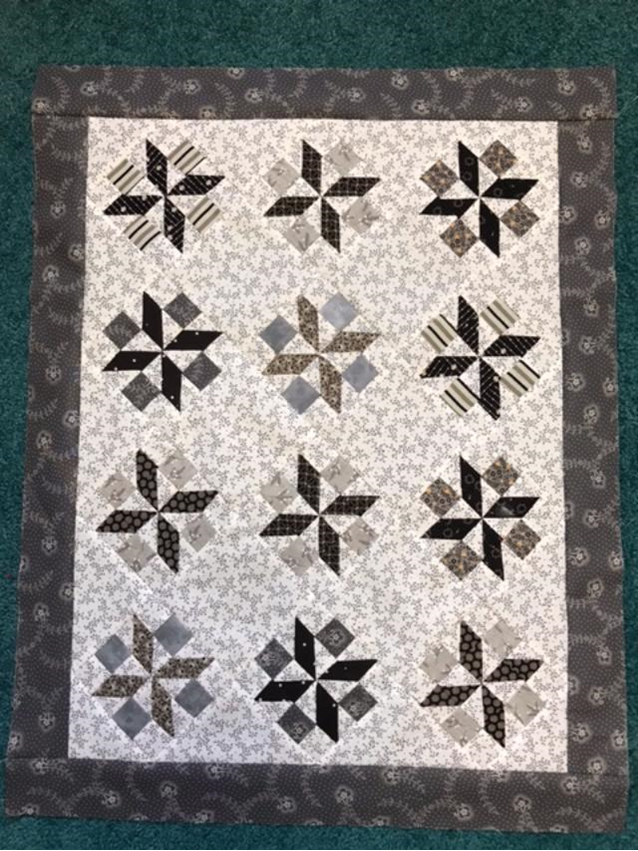
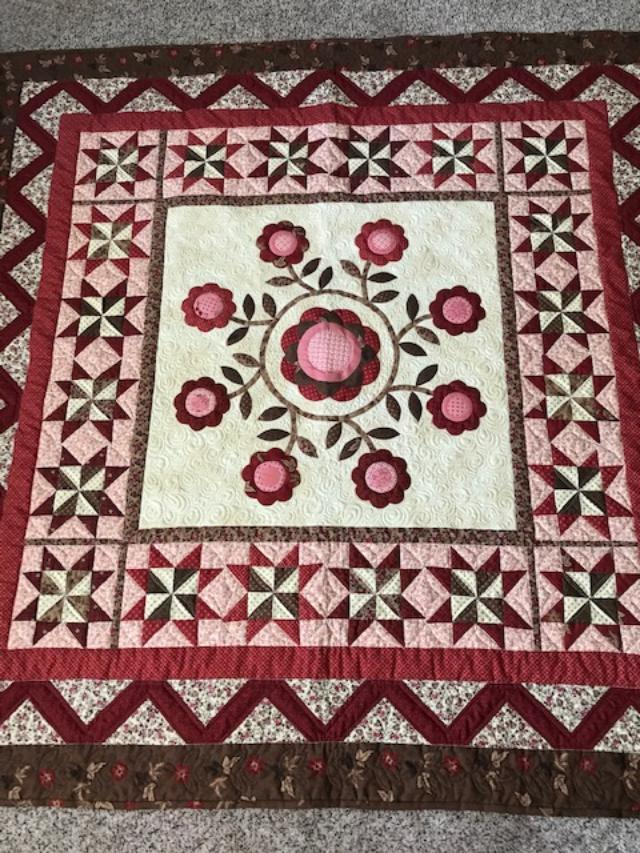

All of these quilts were made by Marie Webster Quilt Guild member Kathy Boxell; a very prolific quilter!
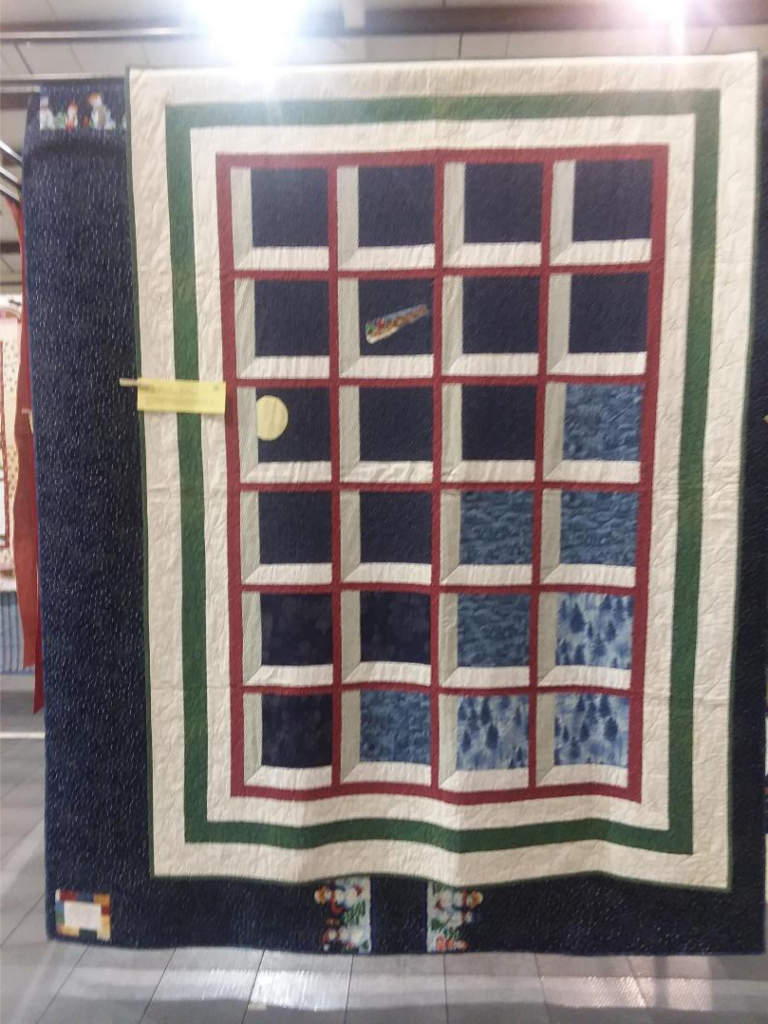
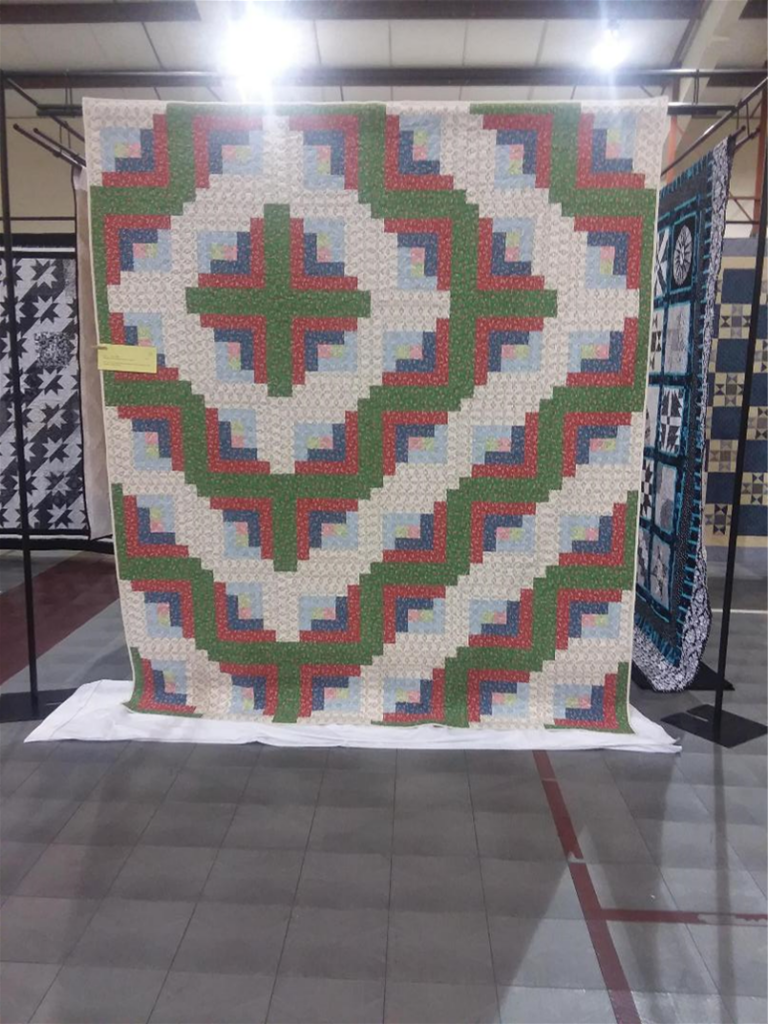
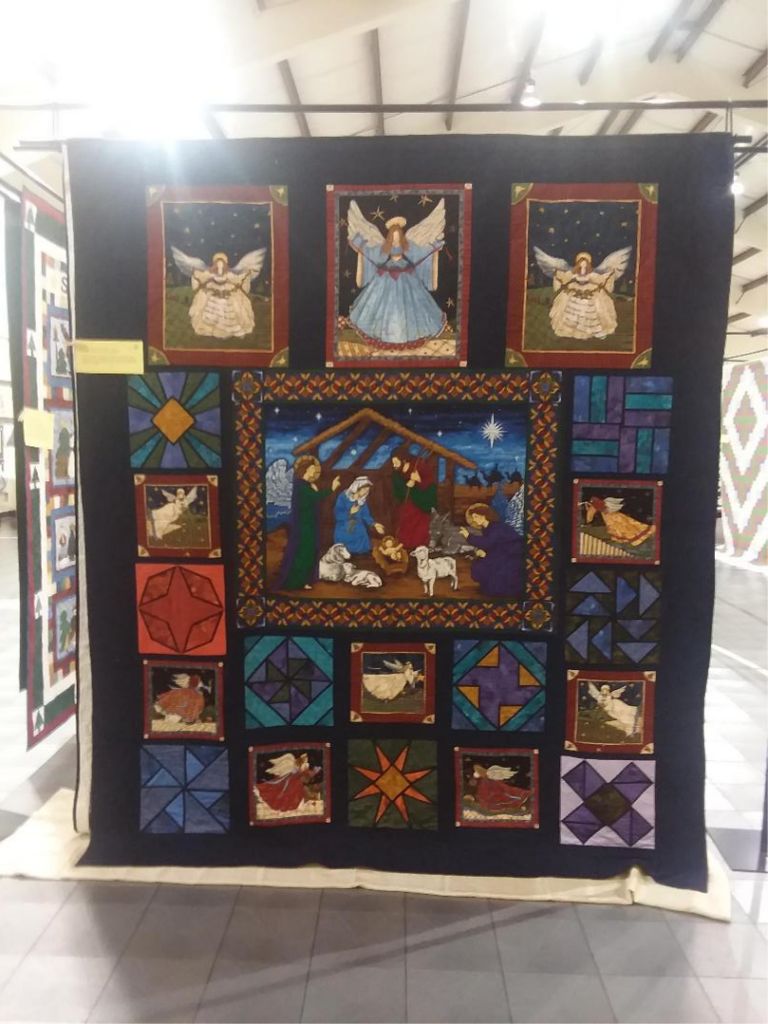
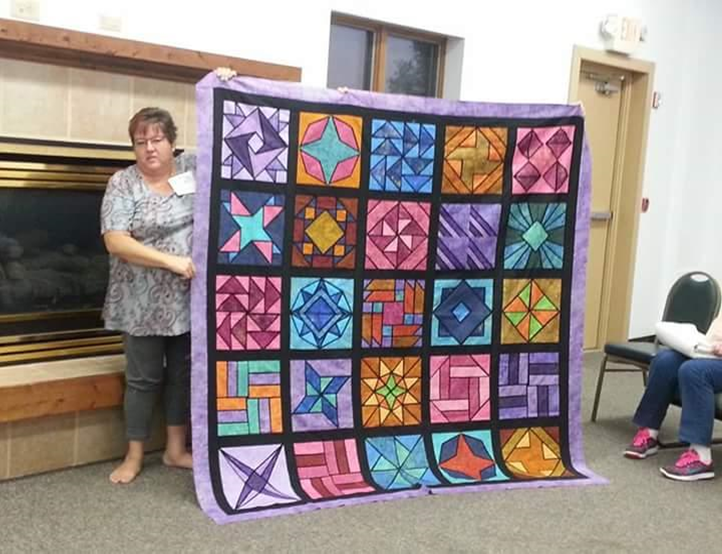
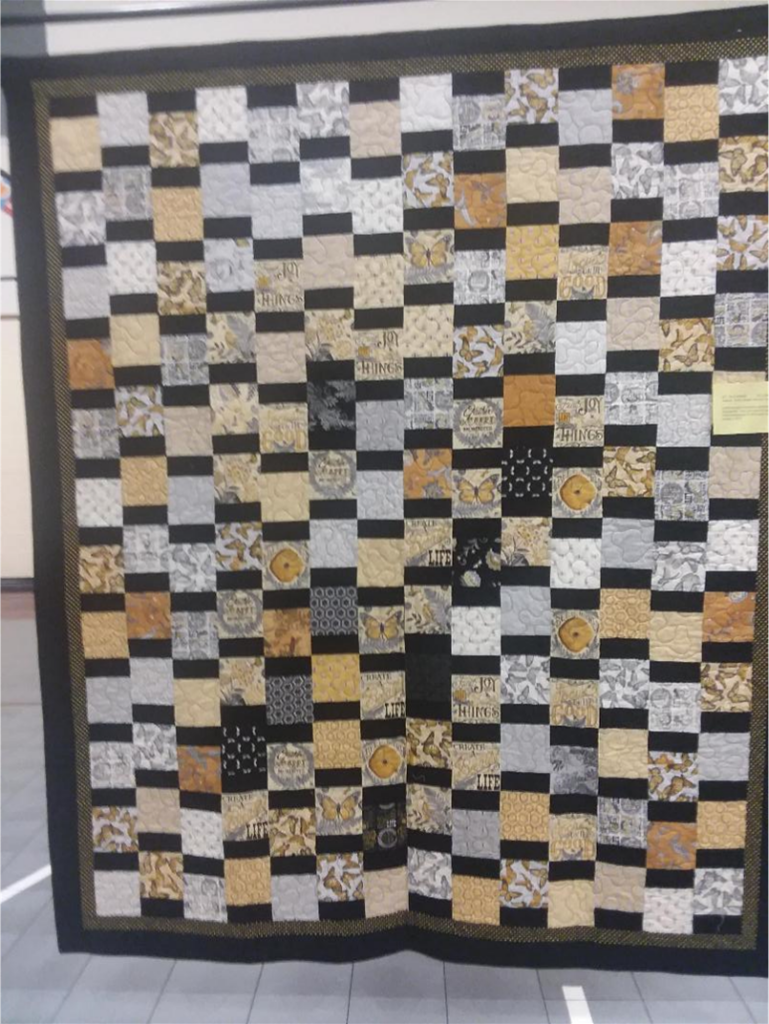
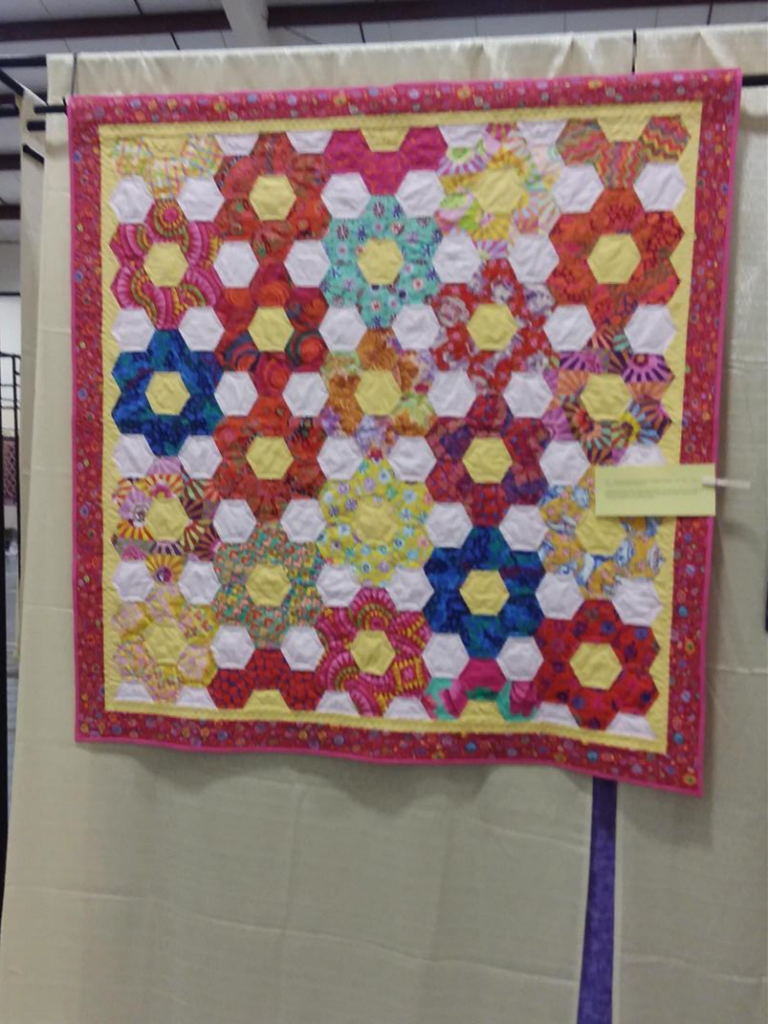
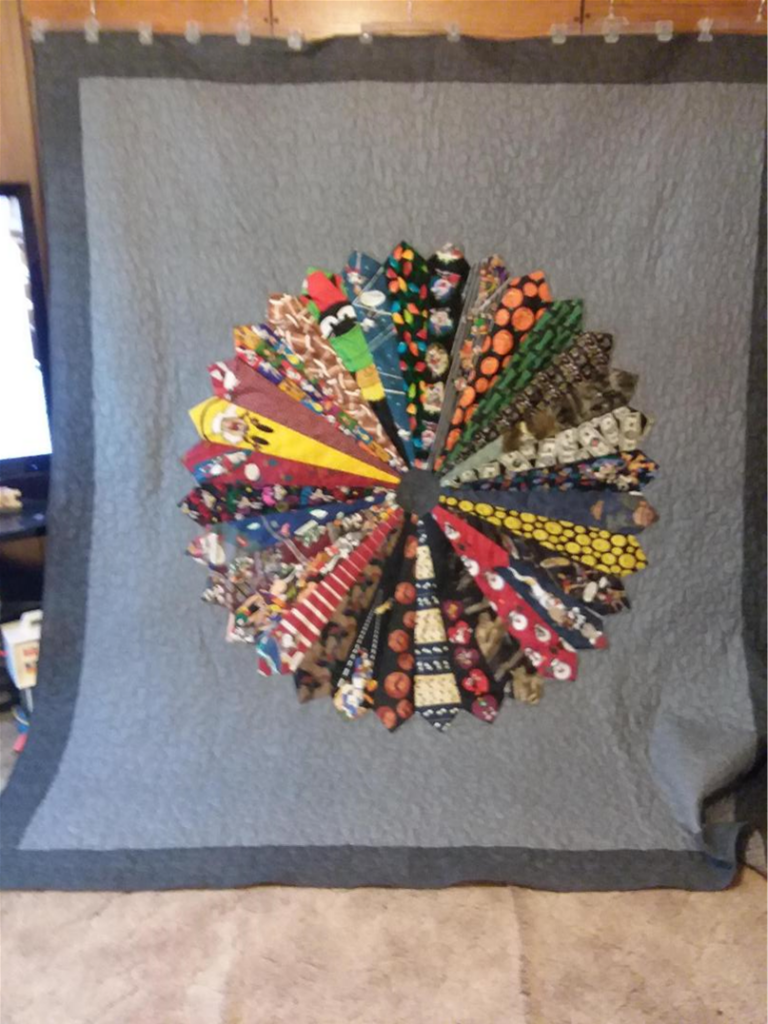
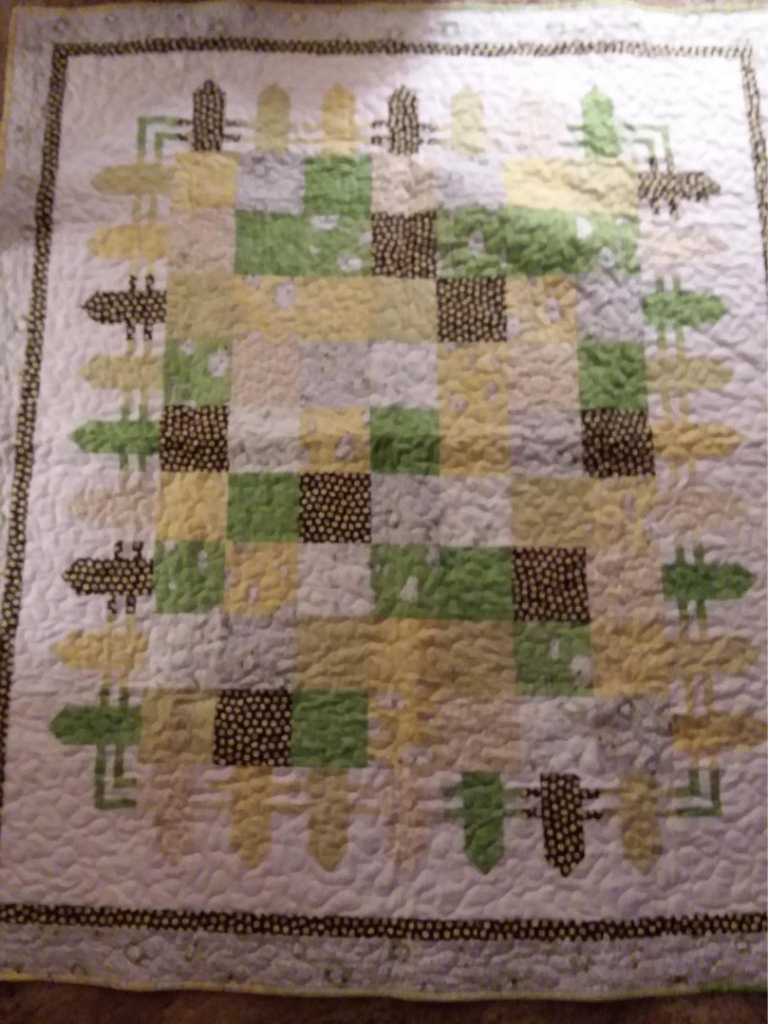
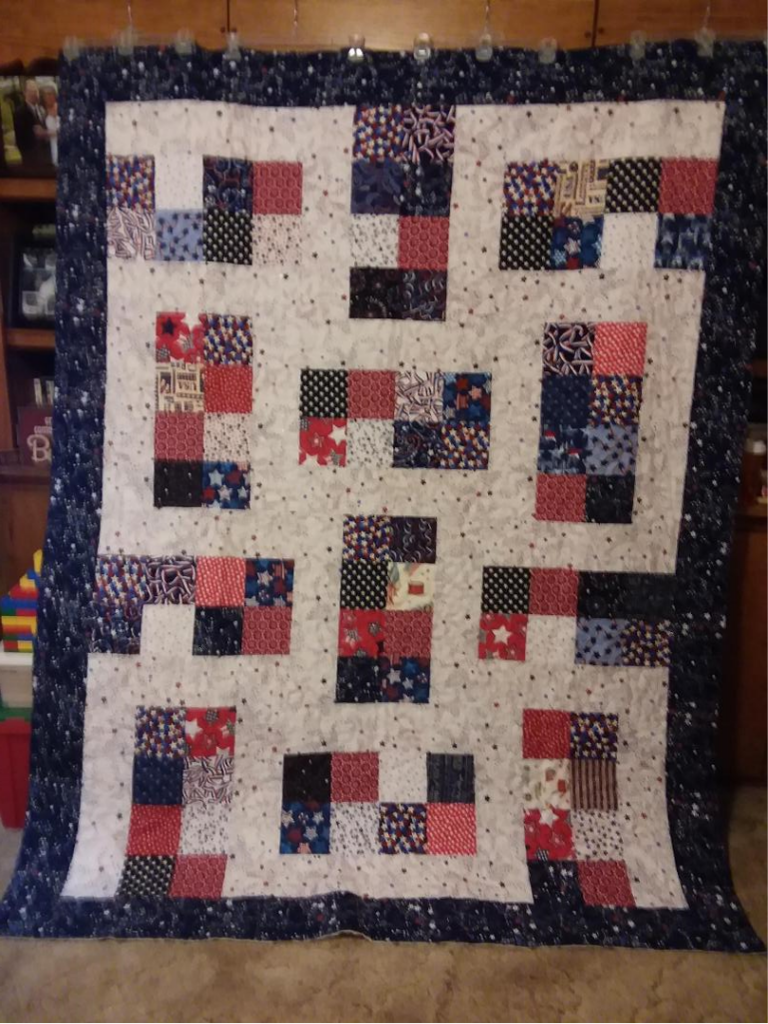
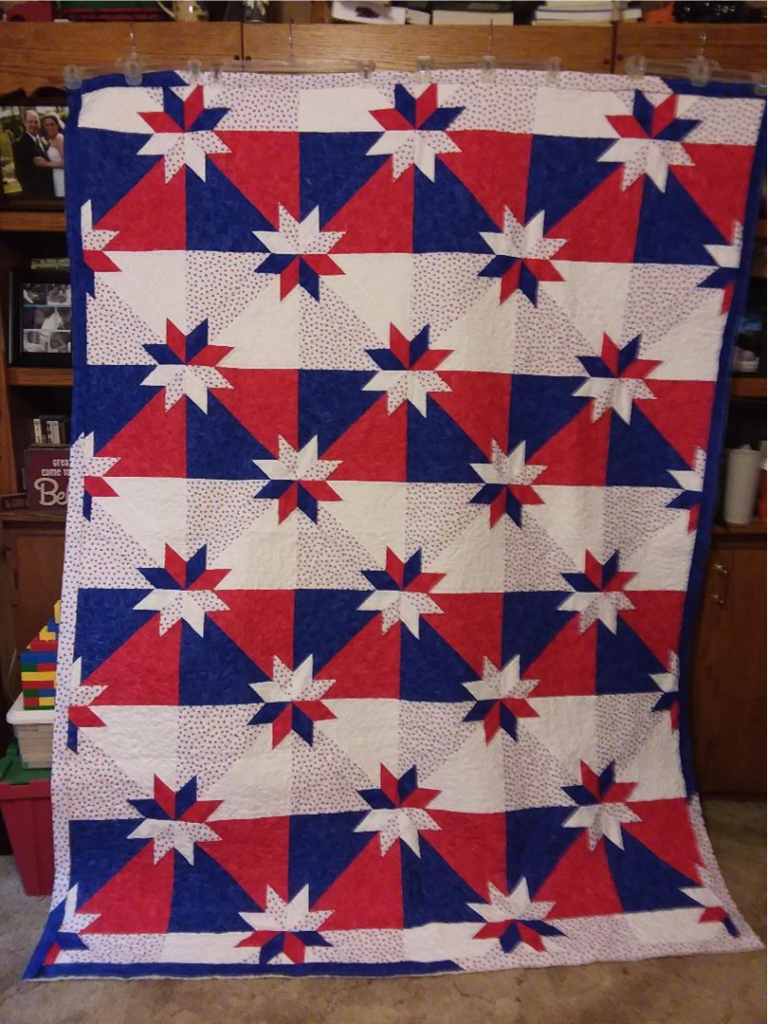
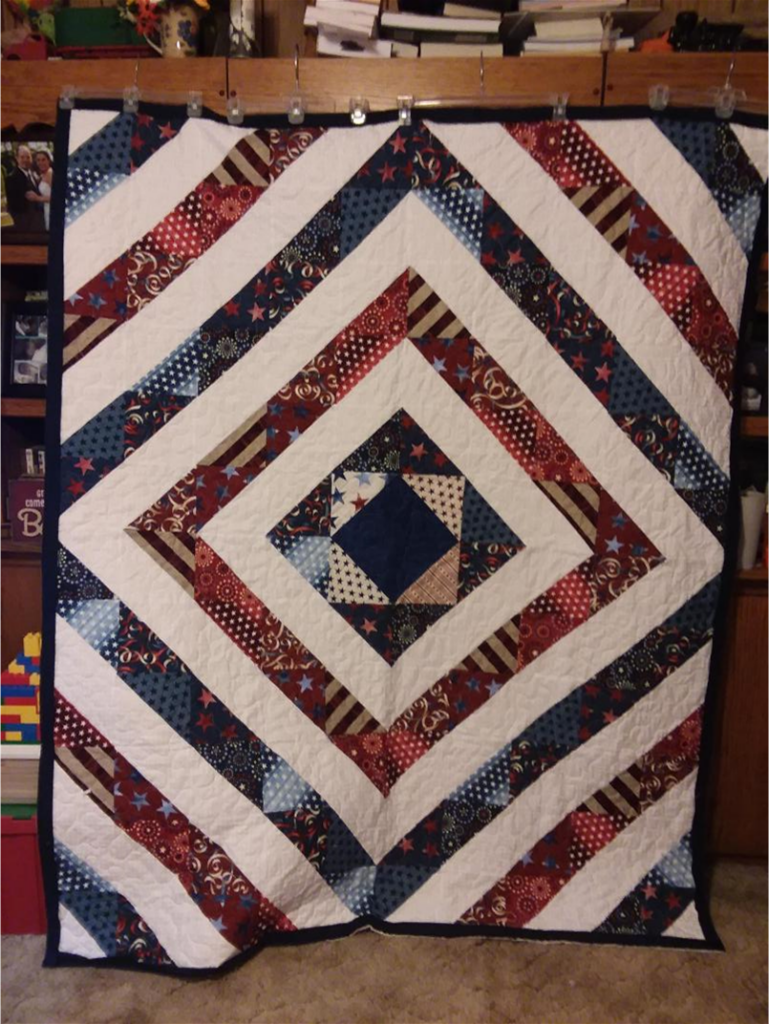
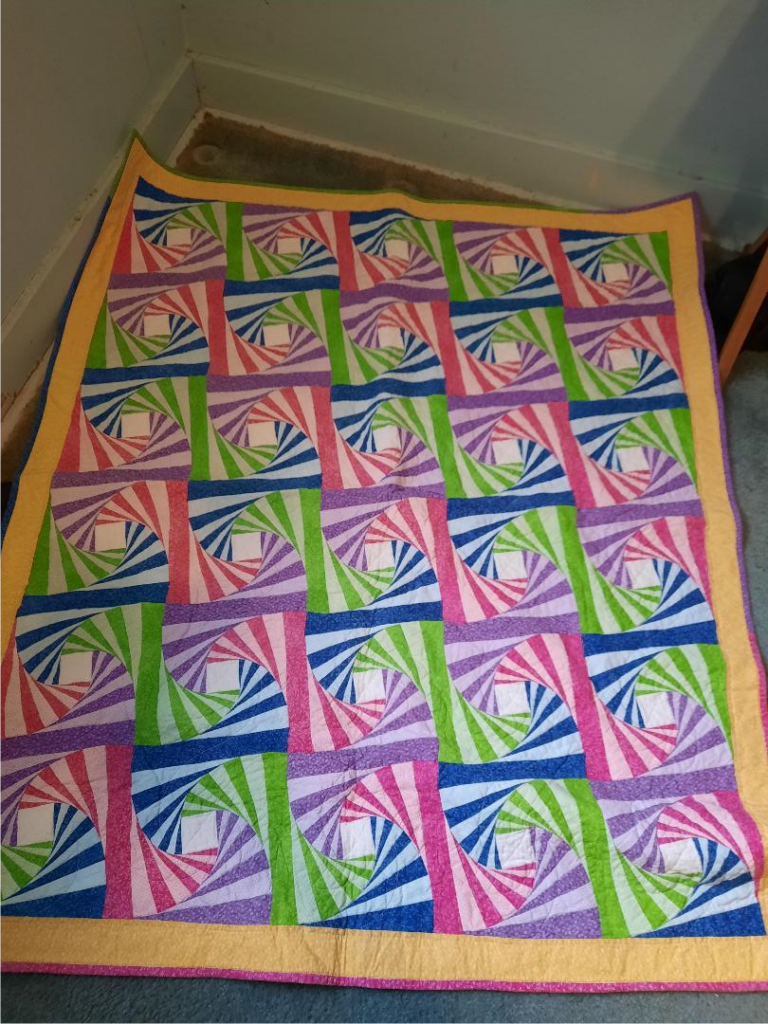
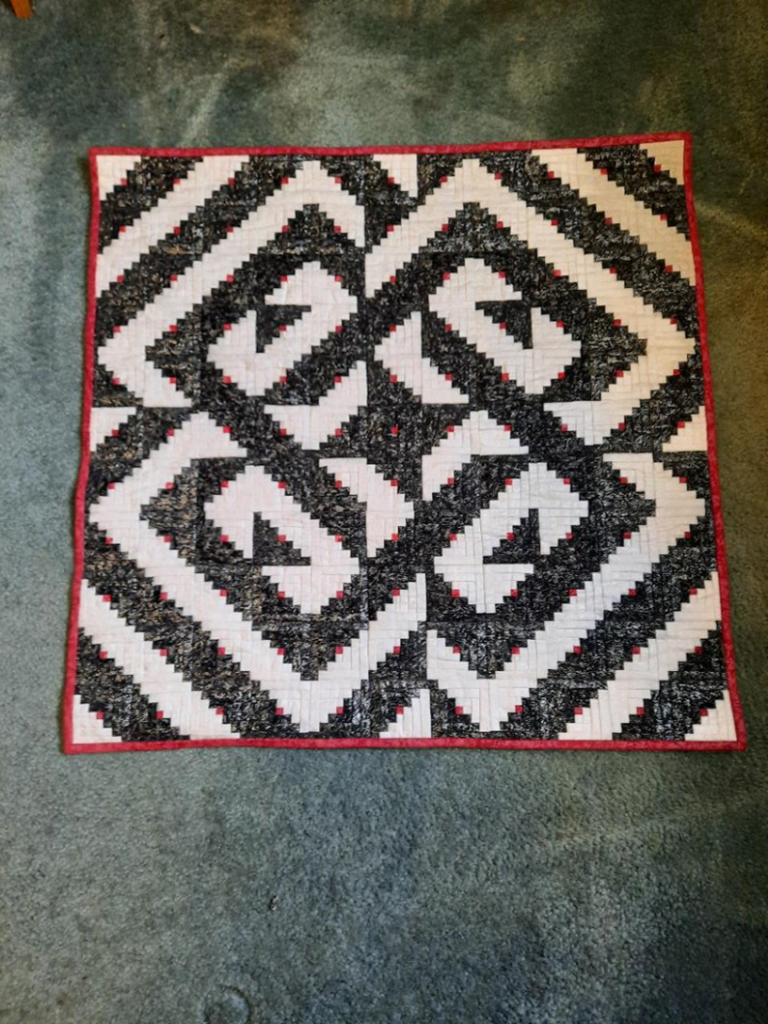
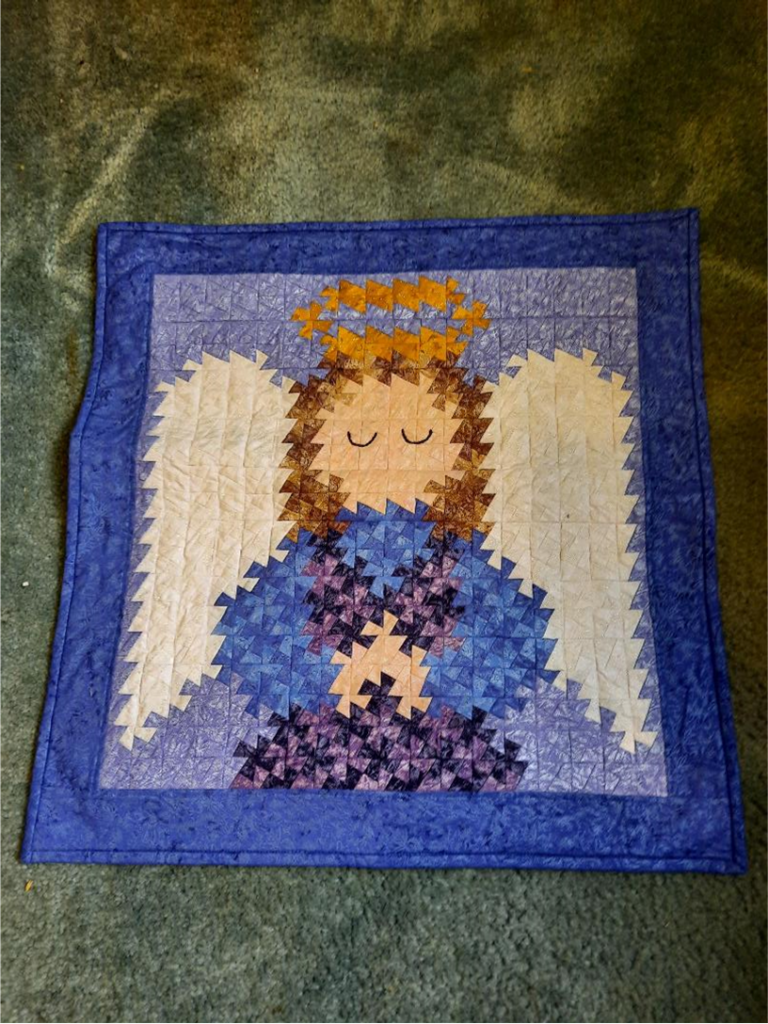
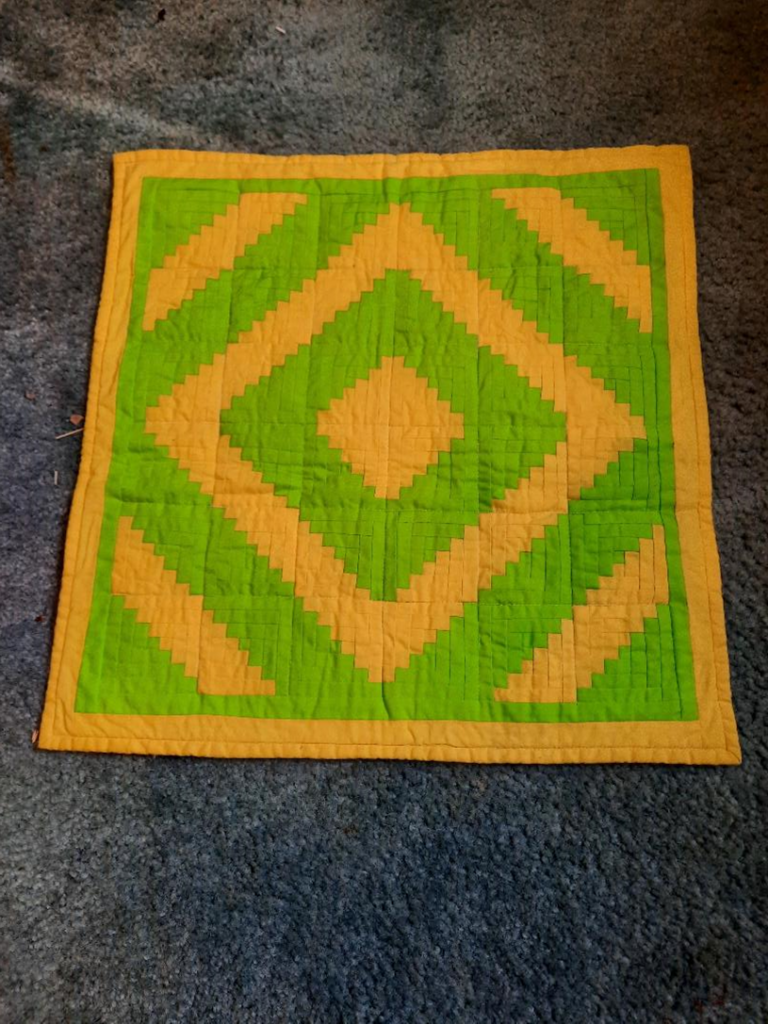
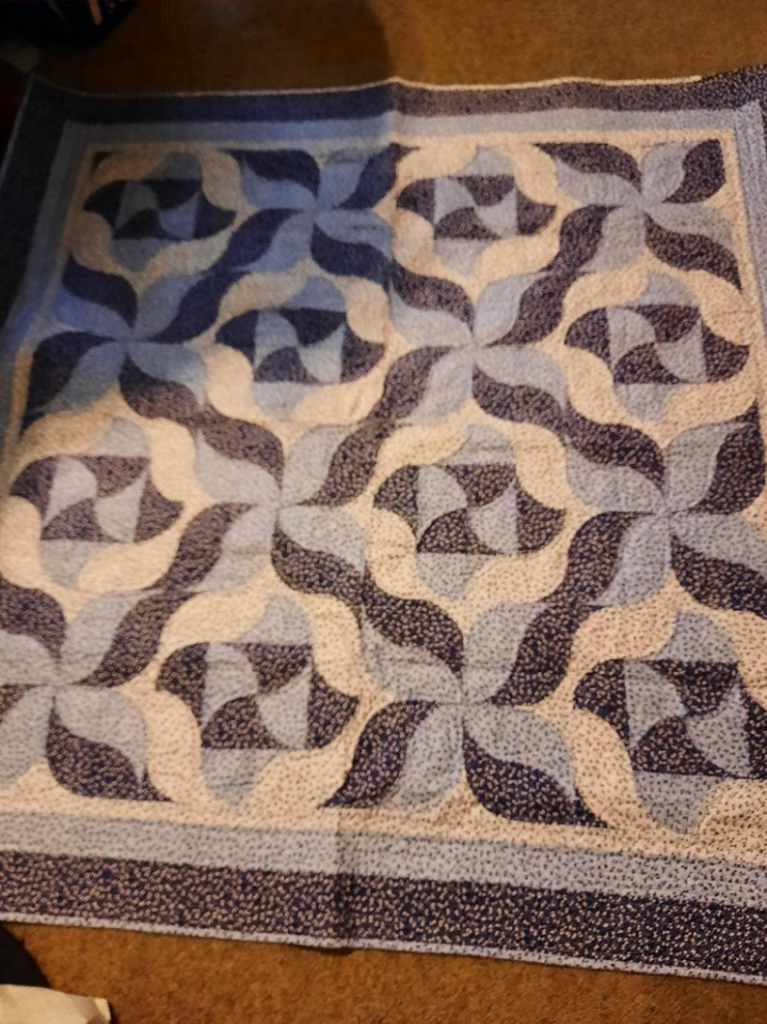
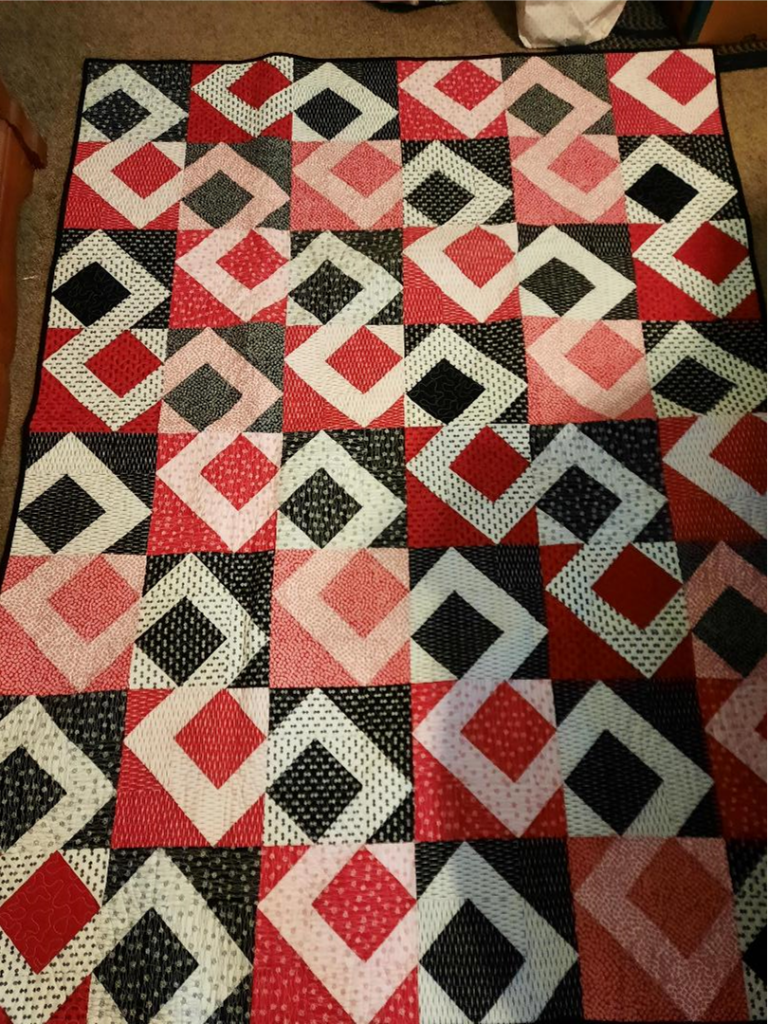
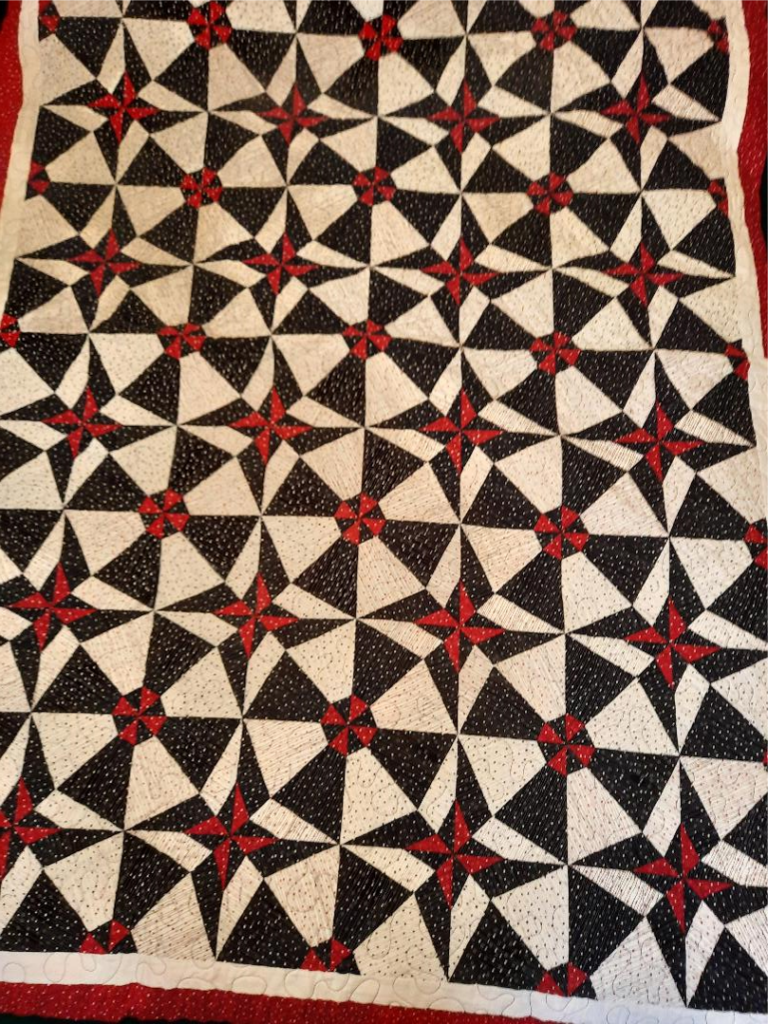
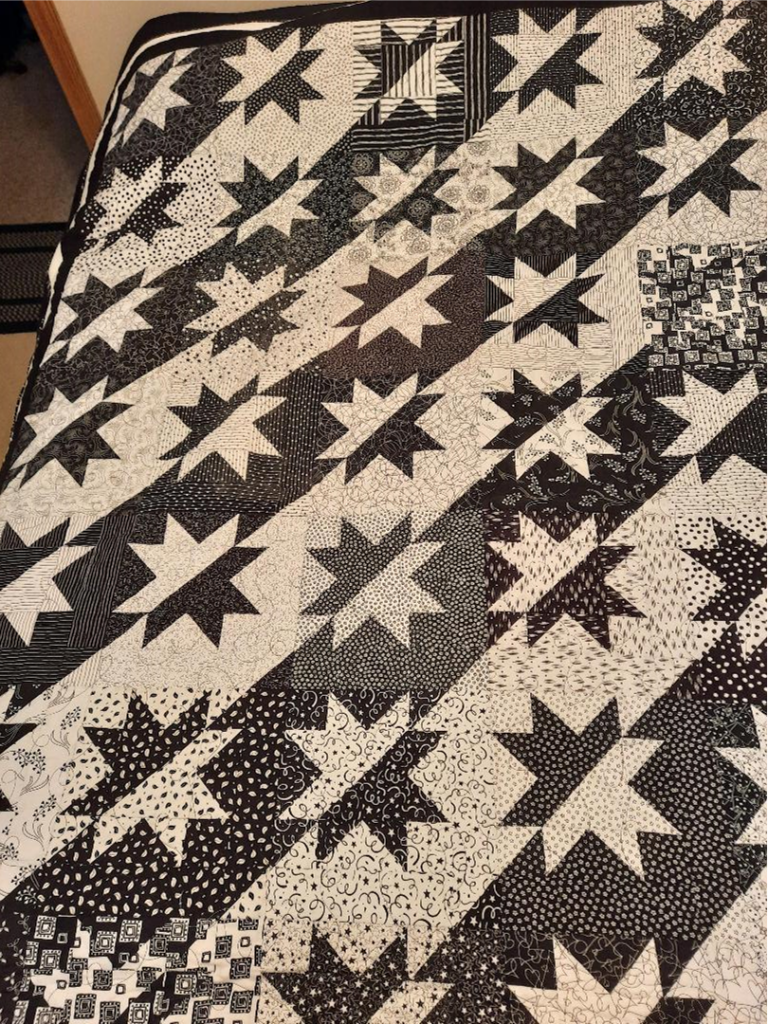
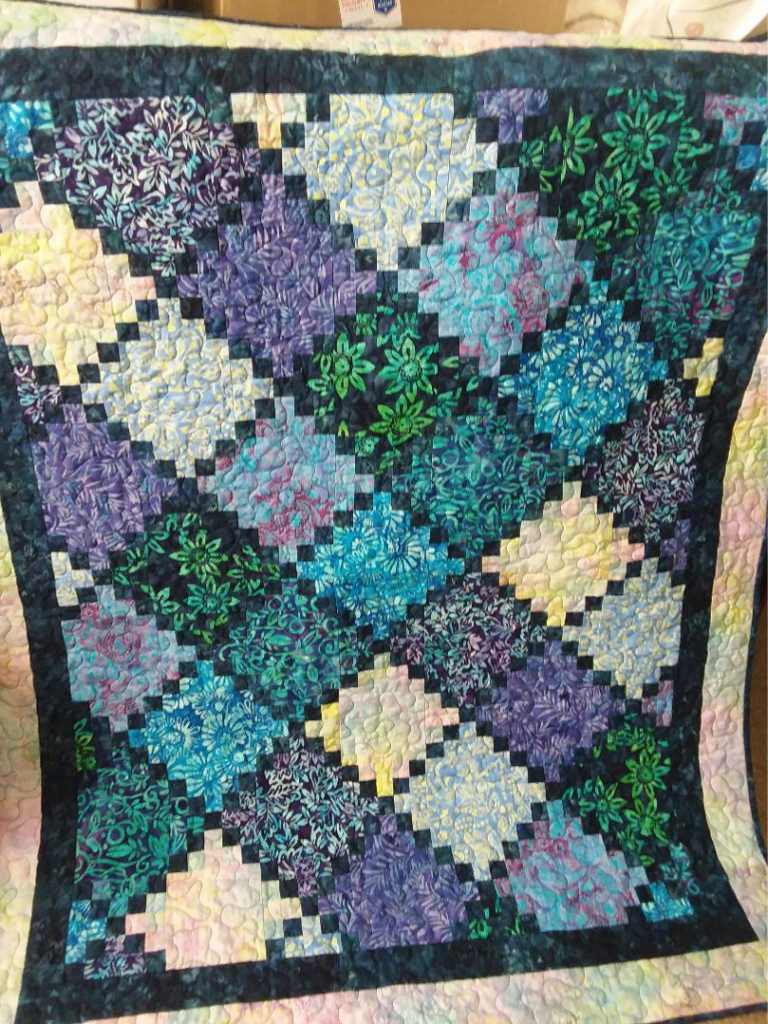
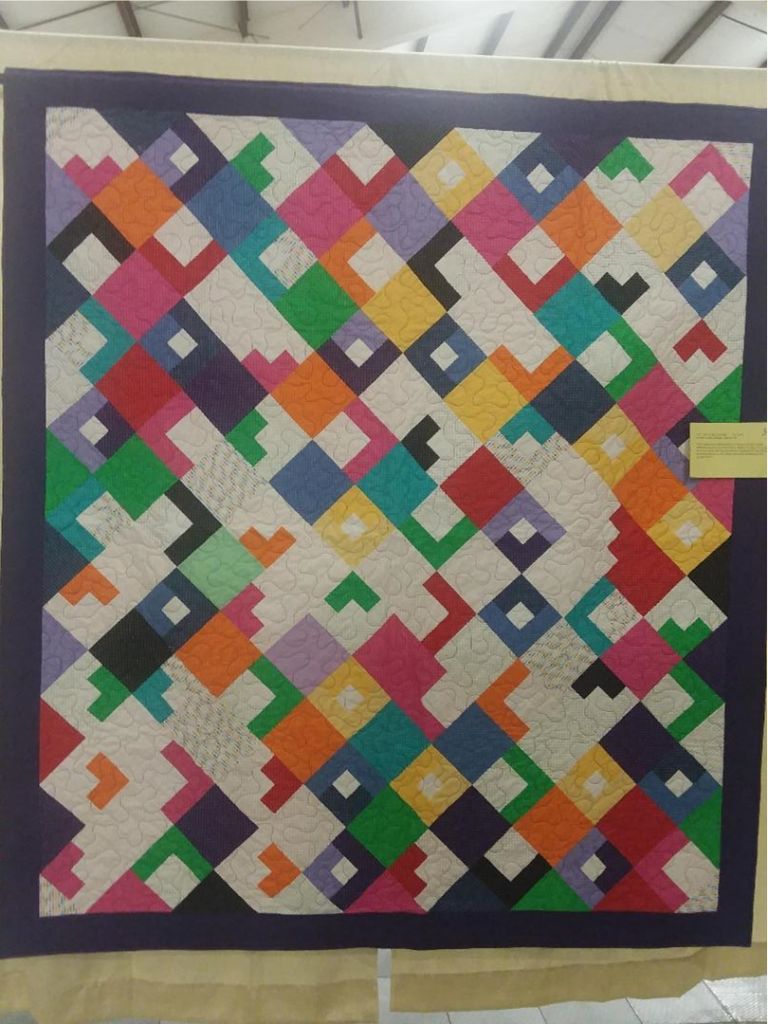
A somewhat belated Happy New Year to you all. I’m looking forward to so much in 2021; we’ll see.
Before I write about this week’s Honoree, I want to do a follow up on Mary McElwain. We had a comment from someone whose mother had shopped at the McElwain store and bought a kit which she never finished. The daughter isn’t a quilter and she wanted some information. With photos of the partially completed top, we were able to identify it as Marie Webster’s May Tulips. You may remember that McElwain had a good business relationship with Webster and carried several of her designs as patterns and kits. Here’s the one that’s in The Quilter’s Hall of Fame collection, in a different colorway than the unfinished one.
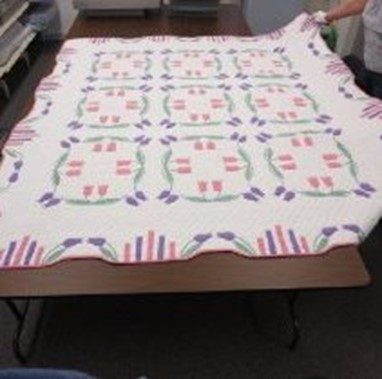
So, I hope this encourages you to leave me a comment if you have a question or reaction to a post. You should also know that TQHF has a searchable collection online if you want to research or browse—that’s how we found the photo above. You can get there easily; from the “About the Quilters Hall of Fame” button at the top of our website, drop down to “Collections” and follow the link to our PastPerfect platform. Not everything in the Collection is cataloged yet (the Collections Committee was set way back this year by not being able to have any work days), but you can still see many interesting pieces. Enough infomercial; on to Amy Emms.
Although many of our Inductees have honors and accolades beyond The Quilters Hall of Fame, only one has been honored by the Queen of England. Amy Emms was named a Member of the Most Excellent Order of the British Empire (MBE)—she got a medal like the one on the right.
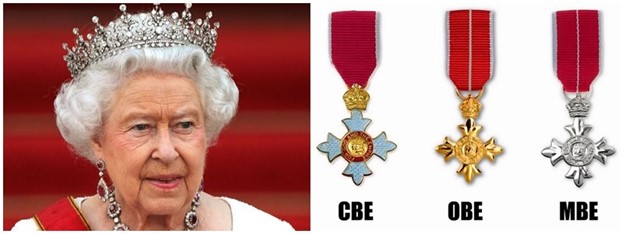
The award was made for her contribution to quilting, in recognition of her decades of work in preserving the cultural treasure of Durham or North Country style quilting. You can read all about Mrs. Emms’ life at the link below, and see a picture of her with her actual medal, but I’m going to touch on some extra “stuff” I found.
Amy Emms came from a home in a generally hard-scrabble area where quilting for hire supplemented the household income for the wives of farmers and widows of miners. Her mother, with Amy’s help as she grew up, earned extra cash by running a “club” in which she would find about twenty clients to buy quilts. They would pay her about one shilling a week until they had covered the full cost of the quilt. Under this scheme, a quilter could buy her materials and produce a quilt about every 3 weeks. Amy recalled that her mother sometimes worked until two or three in the morning. Listen to the brief interview in the link below to find out what Amy was paid for her first work—you’ll love her sweet voice, soft accent, and sly sense of humor.
A lot has changed in 100 years! Now teenagers get jobs at McDonald’s, and practically no one makes quilts for hire any more. Case in point: an acquaintance was looking for someone to make a baby quilt. I was unwilling to do it, even for a fee, so I asked my quilt guild. Not one of our 200 members was interested in doing the work. We’re all hobbyists, interested in the craft for our own amusement, not for income. And before you remind me that there are plenty of long-arm quilting businesses (quilt by checkbook, not by hand), I say the difference is that they serve the hobby community, and don’t make products for sale to the general community. I suppose you could argue that there are art quilters who make quilts for income, but I still demur because there is an element of personal/artistic expression that takes art quilters out of the quilting- for-hire, cottage industry that Emms was a part of.
Which is not to say that there isn’t artistry in Emms’ work. Here’s a quilt she made that was commissioned by the Quilter’s Guild of the British Isles for their collection.
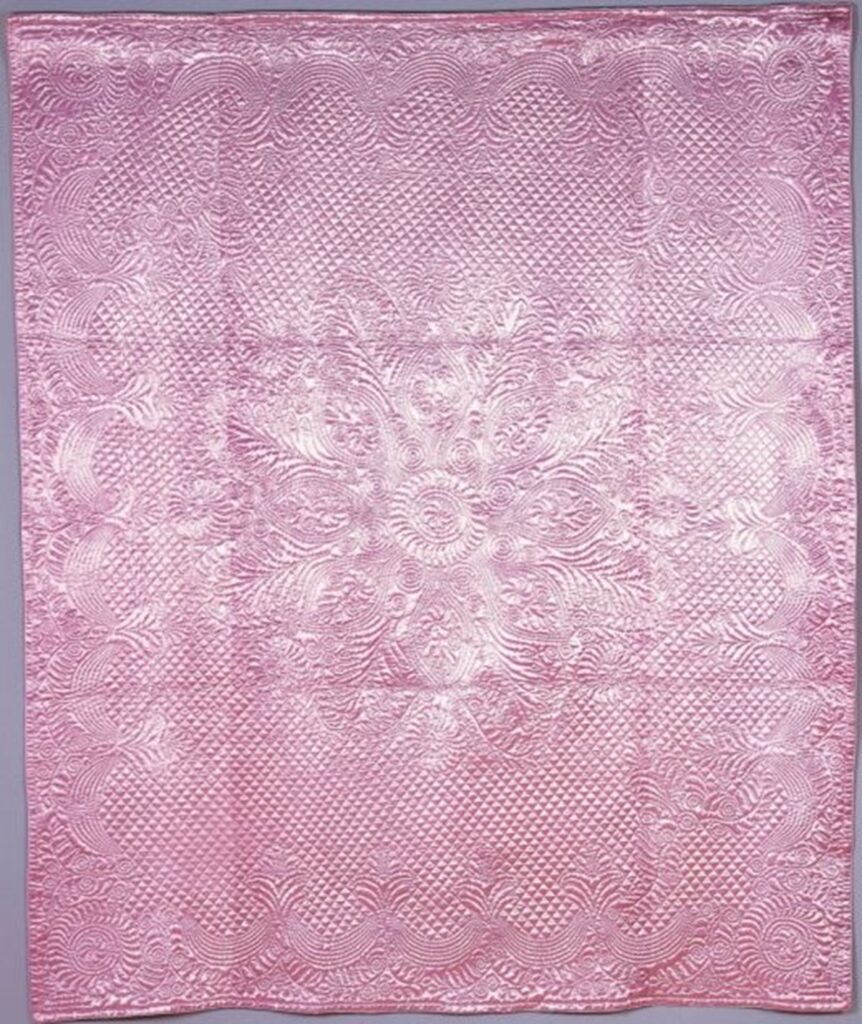
Next are a couple of close ups of the Emms quilt in TQHF’s collection, followed by a higher resolution shot from Barbara Chainey’s site, and then a detail of a quilt she donated to her local museum.
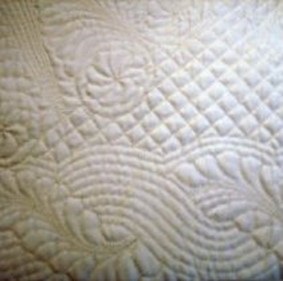
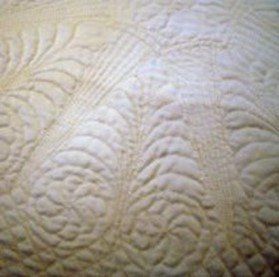
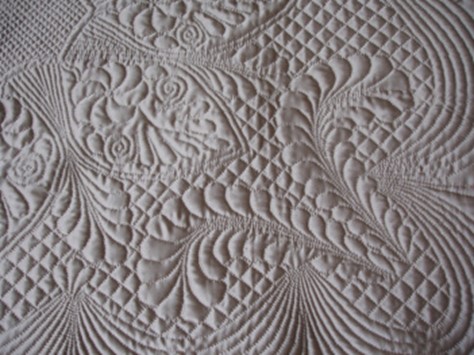
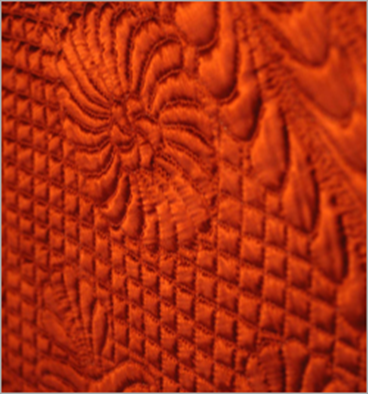
The layout of the pink quilt and the motifs of the others are typical of North Country quilting, and this is what earned Emms her MBE—preserving a regional craft which had been practiced in Northern England since before the Industrial Revolution. This style of quilting is generically under the label of “wholecloth” since they are neither pieced blocks, appliqué nor embroidery and the ornamentation comes solely from the quilting on a plain fabric. Favored quilting motifs were adapted from everyday objects such as flora, feathers, fans, shells, and stars; these were tied together in a flowing manner with wave patterns. When asked about trying new designs, Mrs. Emms replied, “We’ve tried all kinds but they never work like the old ones.” (Interview with Dr. June Freeman, 1983)
Emms wrote a book about her style of quilting. She uses the name “Durham” for the county of her home town, Sunderland. In recent times, County Durham has been consolidated into Tyne and Wear, so I’m using the broader term, “North Country”. If you are interested in more information about whole cloth quilting in England and Wales, and especially the differences in the styles, I’ve put a link below for an excellent blog entry on the subject. Here’s the Emms book; it’s widely available online.
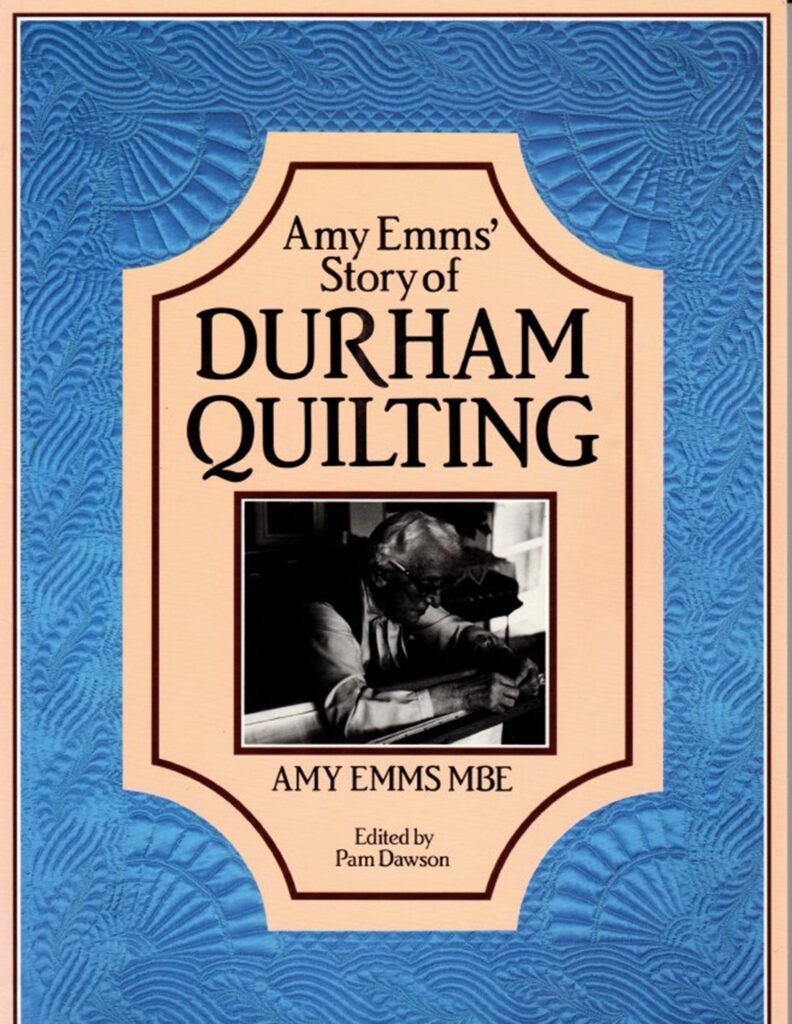
North Country quilting is also seen on cushions, dinner jackets and evening gowns. Amy Emms made a quilted wedding gown for her daughter, Olive. With typical Emms humor, Amy told Olive that she shouldn’t worry about the weight, and that “afterwards you could always make pram sets from it”. (Interview with Dr. June Freeman, 1983) Here’s a photo of Olive on her big day wearing what Amy referred to as a big round quilt. After the wedding, the dress was displayed at the Sunderland Museum.
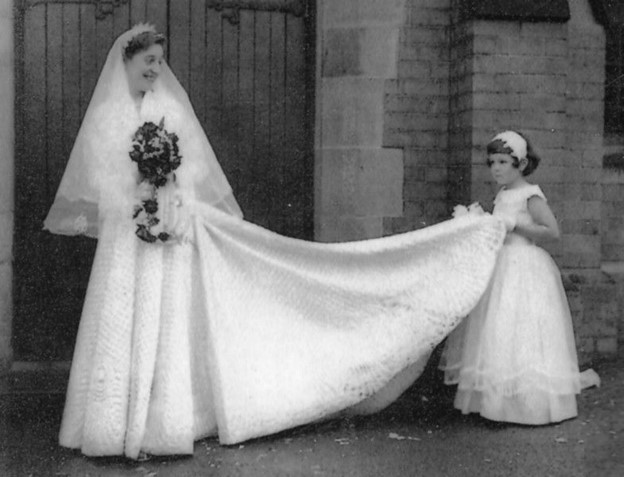
And here’s a stunning bit of quilting on that most mundane article of clothing—the housecoat. This one was made by a student of Emms in the 1960s.
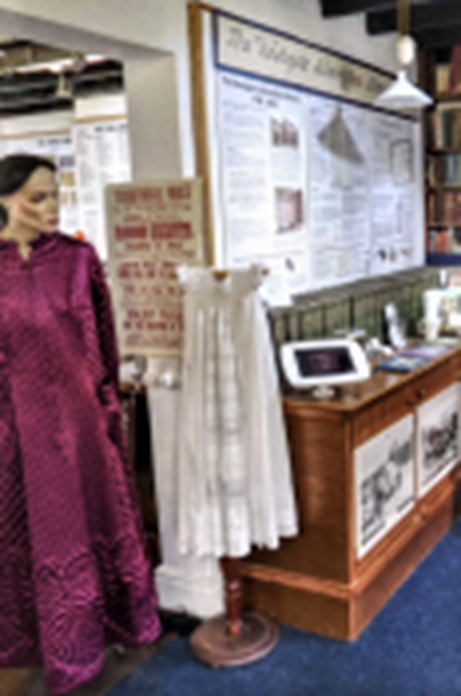
I mistakenly think of fashion quilting as starting with Honoree Virginia Avery in the 1970’s, but these examples are a few decades before that. I’m always learning! And, by the way, I would definitely wear a housecoat that looks like that.
The housecoat is my segue to the other “service” that put Emms on the Honours List: her teaching. After winning top prizes in local contests for eight years in a row, she decided to give others a chance, and she turned to teaching. She started during the Second World War through the British Legion organization which promoted fund-raising activities, and she continued giving evening classes for almost two decades. After Olive’s wedding dress was seen, locals had to enter a lottery to gain a place in Amy’s classes. Here are two photos of Emms’ teaching efforts.
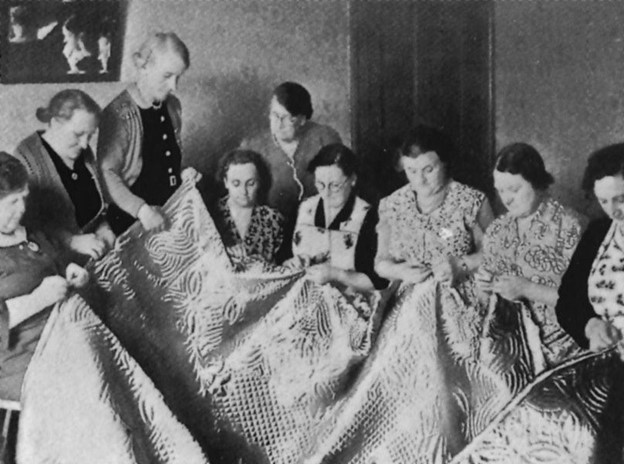
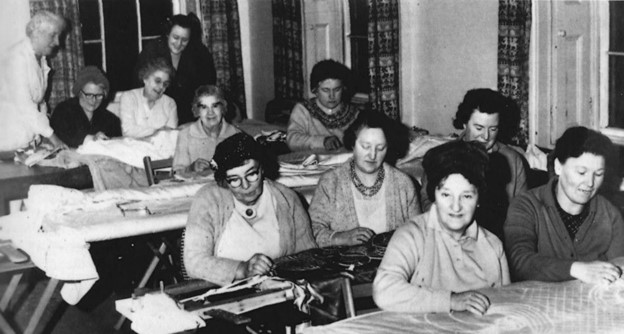
Emms’ legacy continues to this day, and her name is preserved in the Amy Emms Memorial Trophy presented at the annual British National Quilt Show, Quilts UK . The Quilter’s Guild of the British Isles also keeps her spirit alive through a Bursary (grant or fellowship) awarded biennially in her name.
I’ll close with a photo of Mrs. Emms doing what she did best.
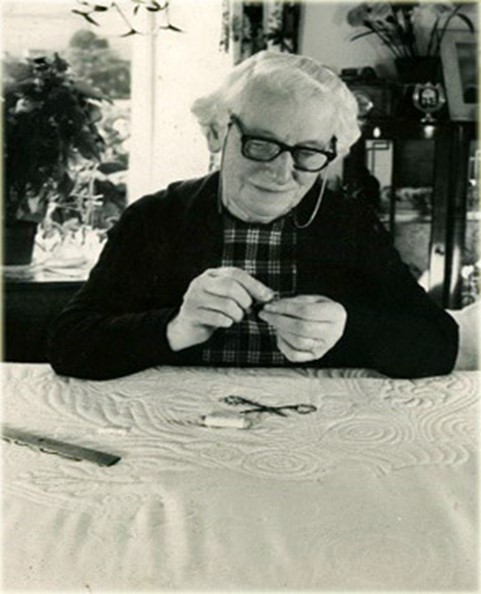
Your quilting friend,
Anna
PS. This almost makes me want to do some hand quilting, but I know myself better than that!
Bio information https://quiltershalloffame.net/amy-emms-m-b-e/
Interview about economics of quilting Interview https://www.gettyimages.com/detail/video/exhibition-of-quilts-at-london-crafts-council-amy-emms-news-footage/809794592
TQHF quilt https://quiltershalloffame.pastperfectonline.com/webobject/CB1A8218-3C1F-4094-8834-552172864358
More on quilting styles http://welshquilts.blogspot.com/2012/01/difference-between-welsh-and-durham.html
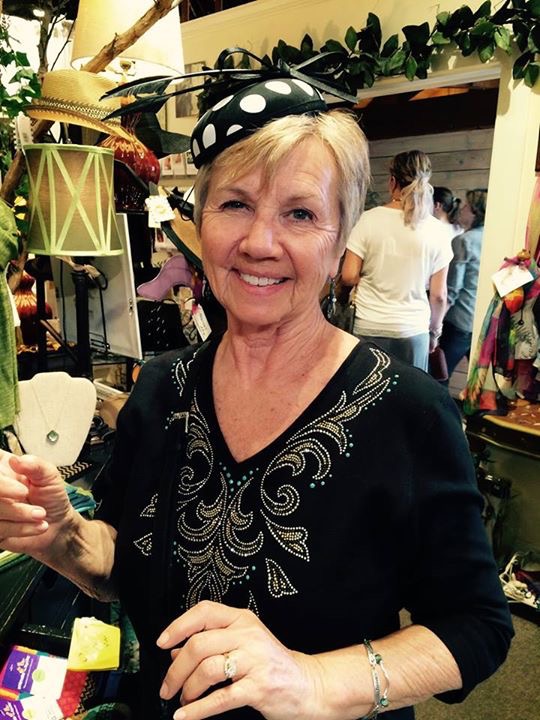
All of these quilts were made by Marie Webster Quilt Guild member Julie Spangler; a very colorful quilter!
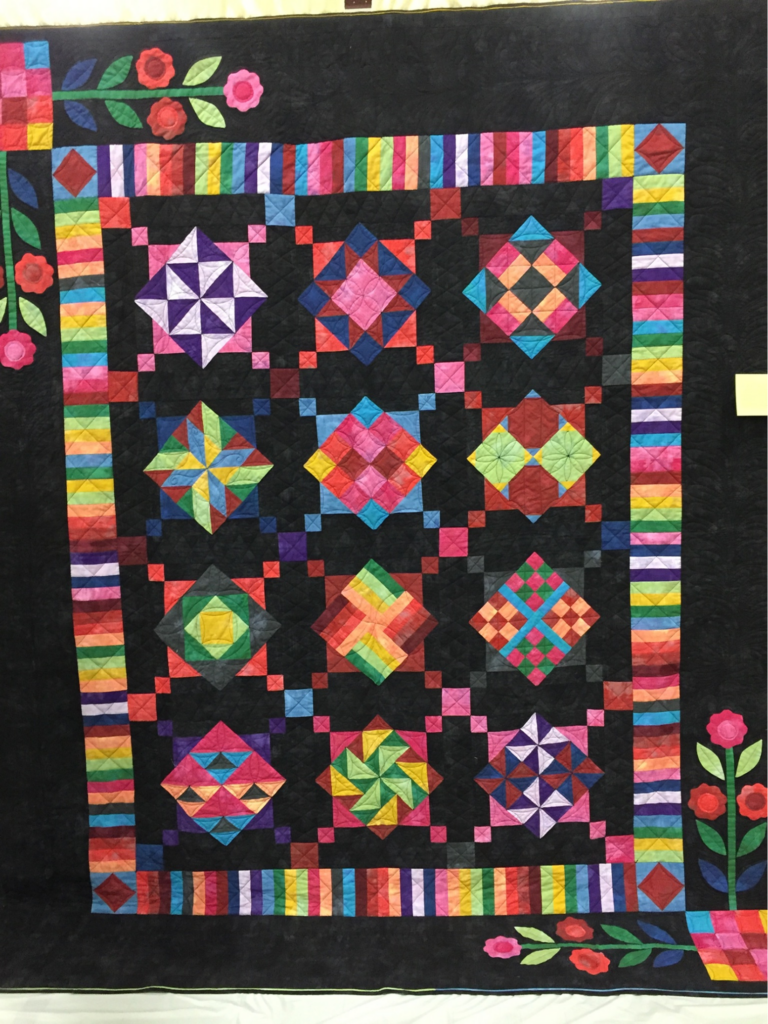
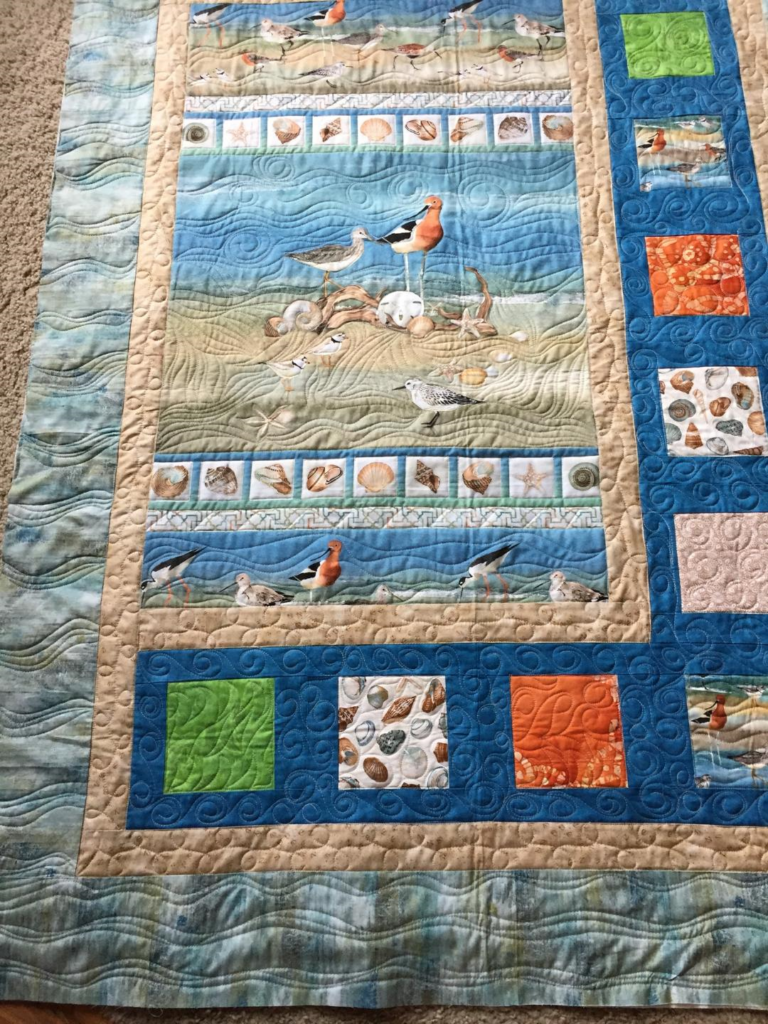
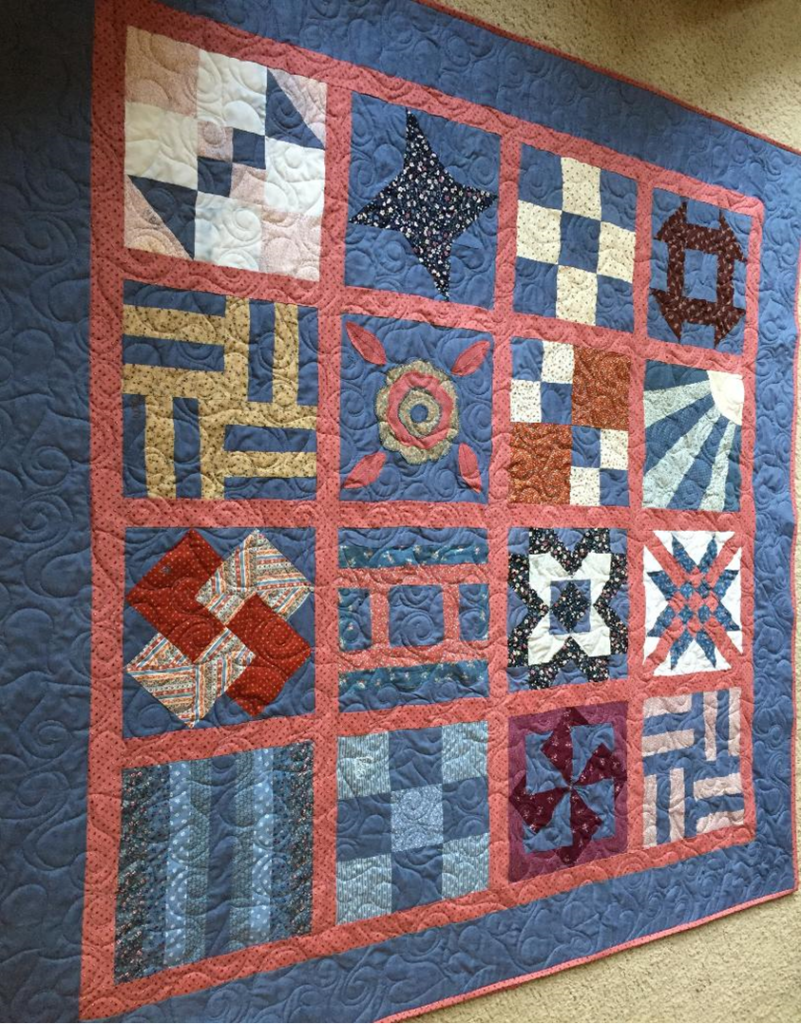
This sampler quilt was the result of a quilt challenge with a group from Sunnycrest United Methodist Church in the 70’s. One of my sisters, Gloria Yoars and Marie Webster Quilt Guild member, Barb McClure, also participated in this challenge.
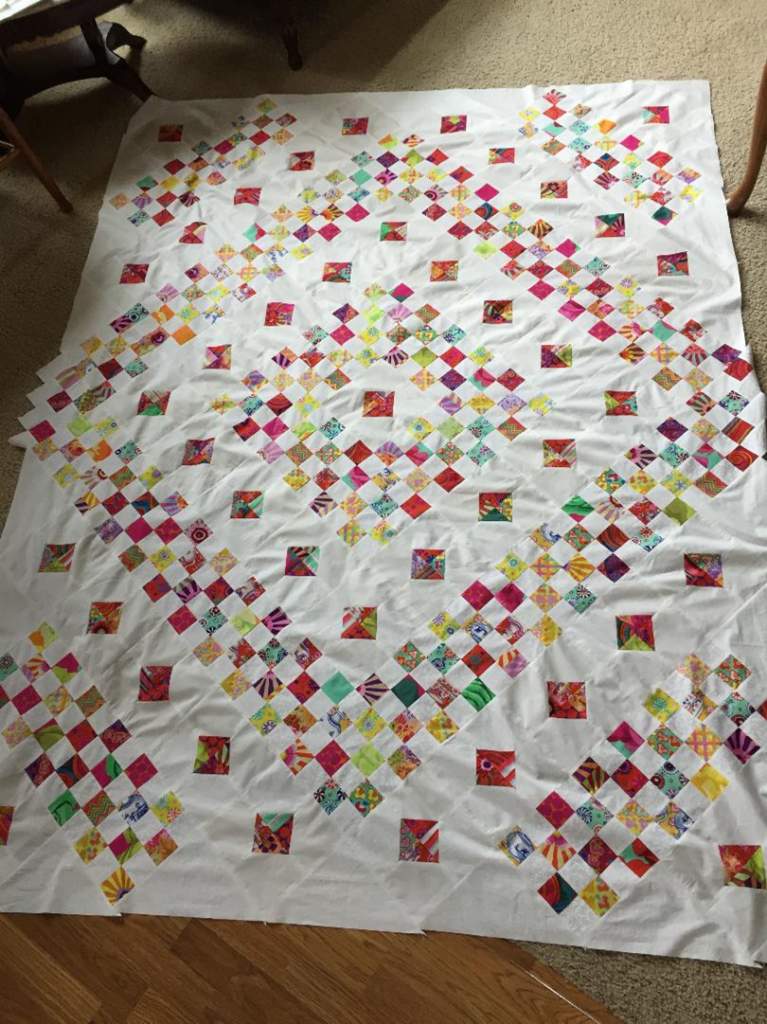
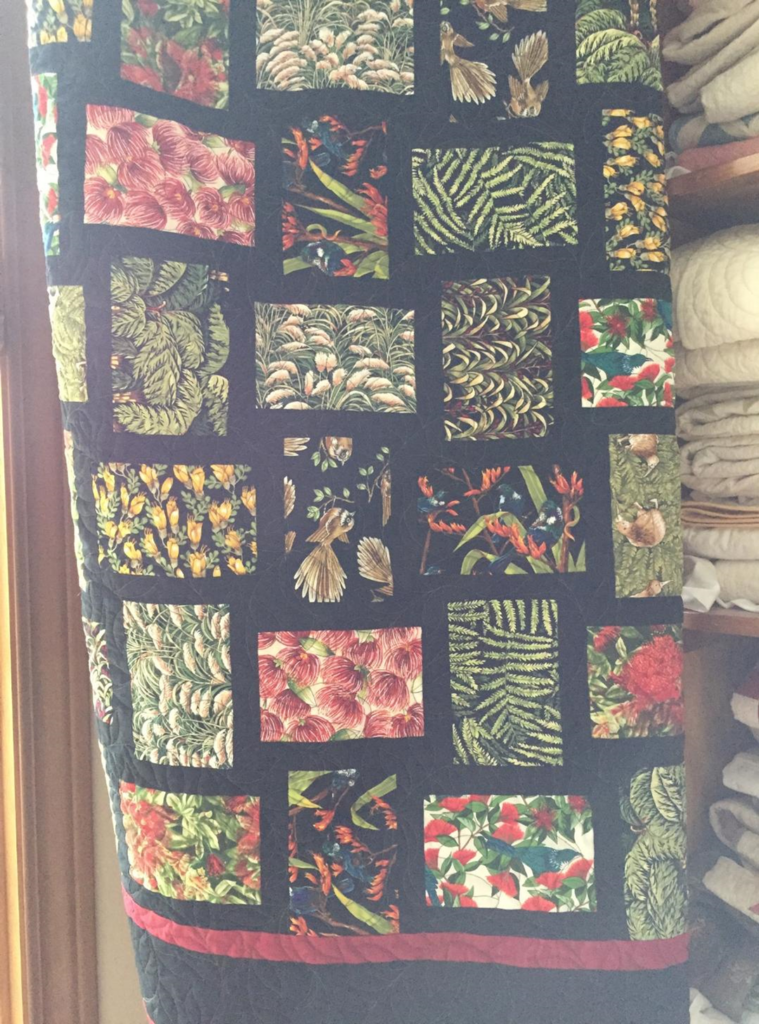
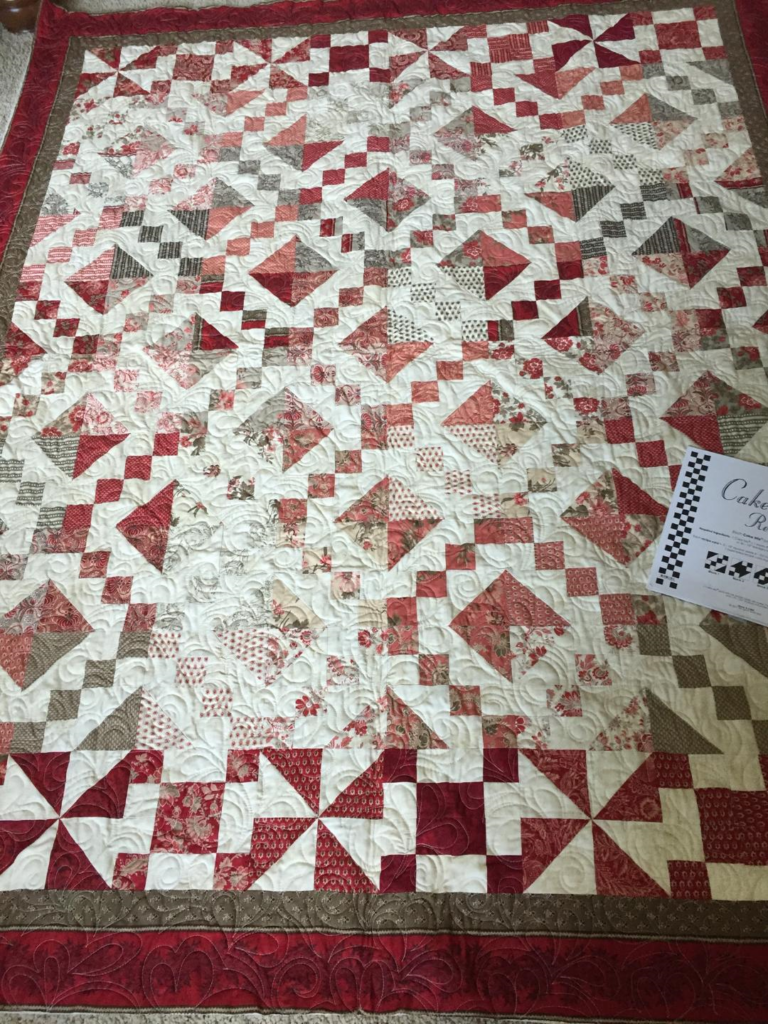
This quilt is the result of the 2020 Sisters’ Challenge with the Hostetler Girls. We all used one Cake Mix pack and our own fabric choices.
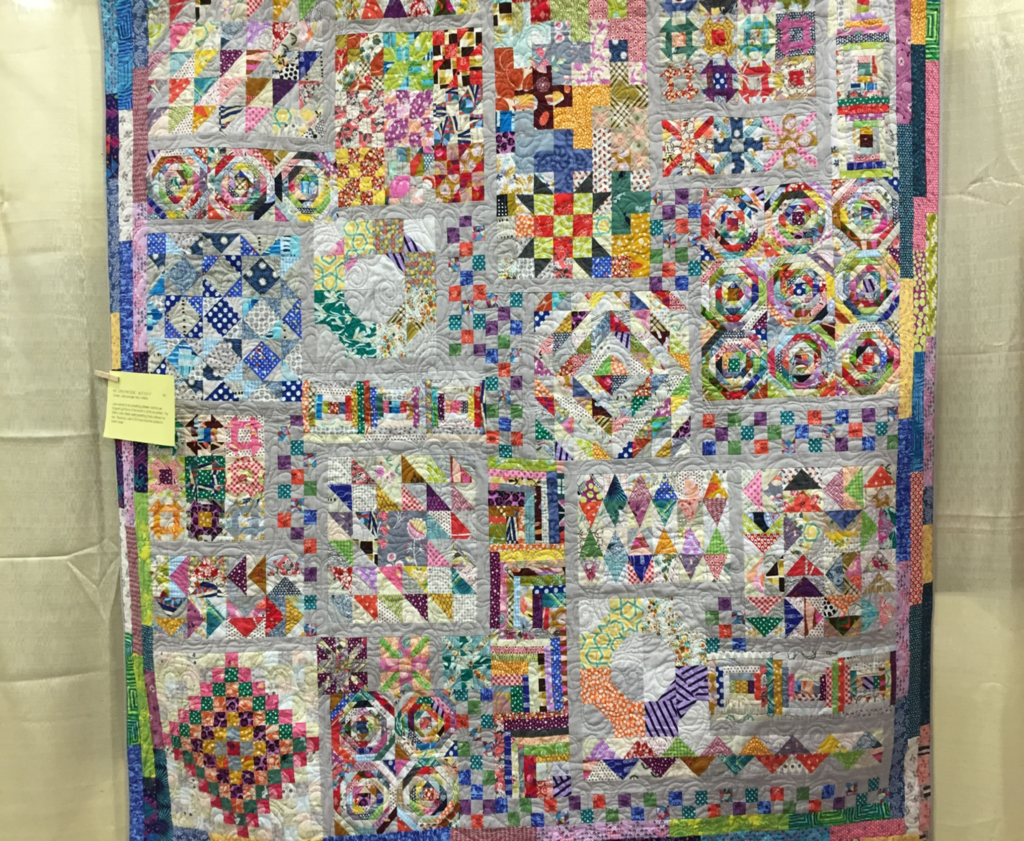
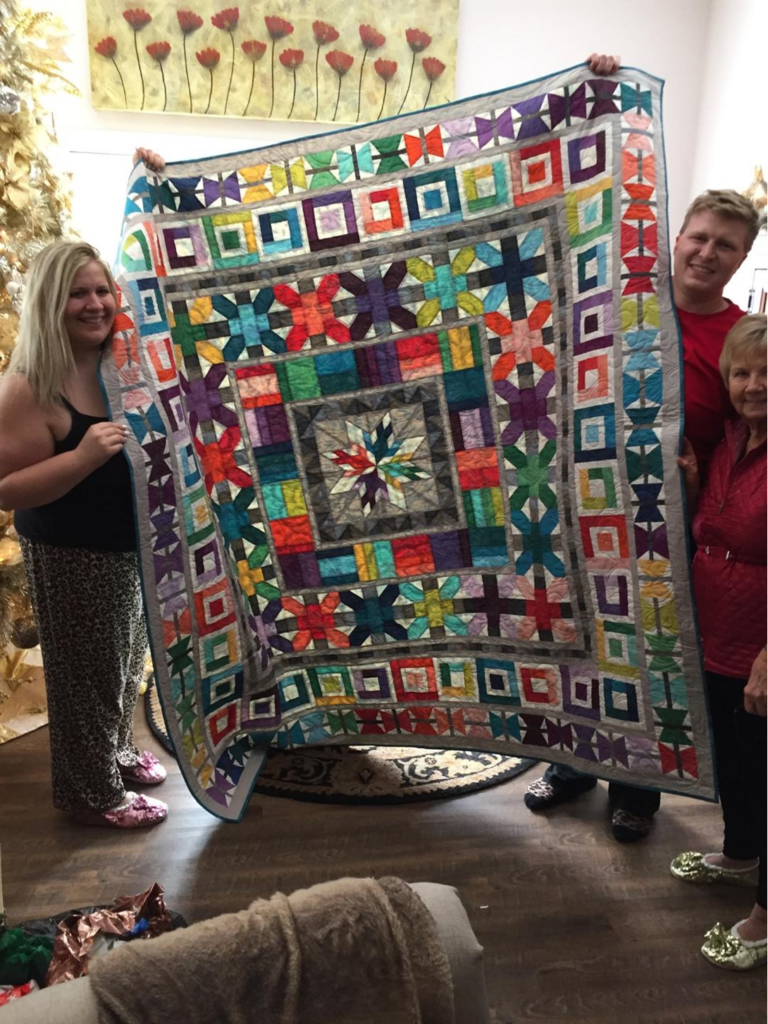
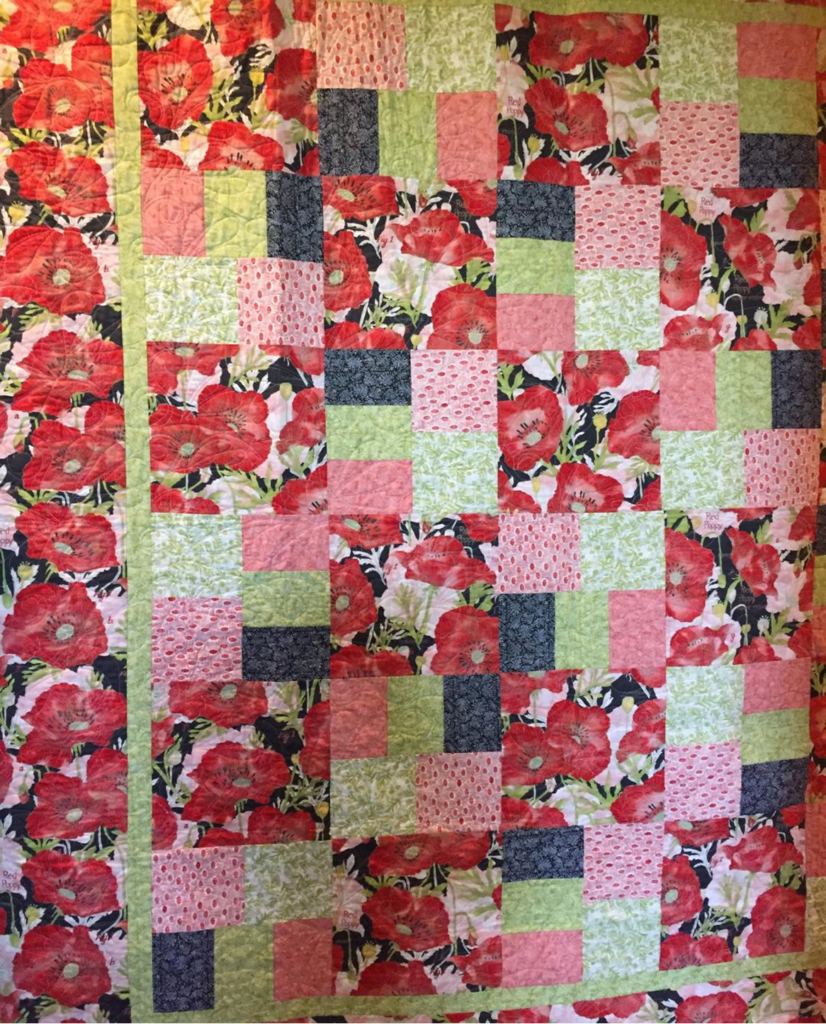
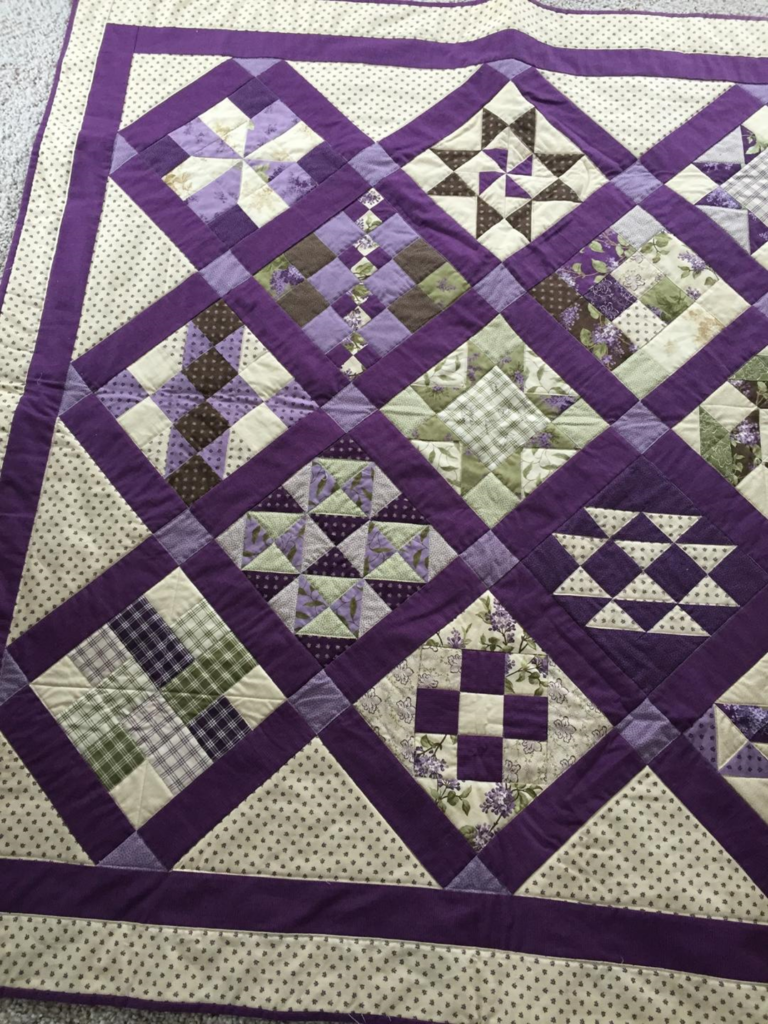
This quilt is the result of a Sisters’ Challenger 2019, a yearly quilt challenge with my six sisters-in-law. My sister-in-law, Joyce Hostetler, wrote a Block-of-the-Month for all of us and we all had the same MODA layer cake with which to make our quilts. The quilts were all different, even though we all used the same pattern and layer cake.
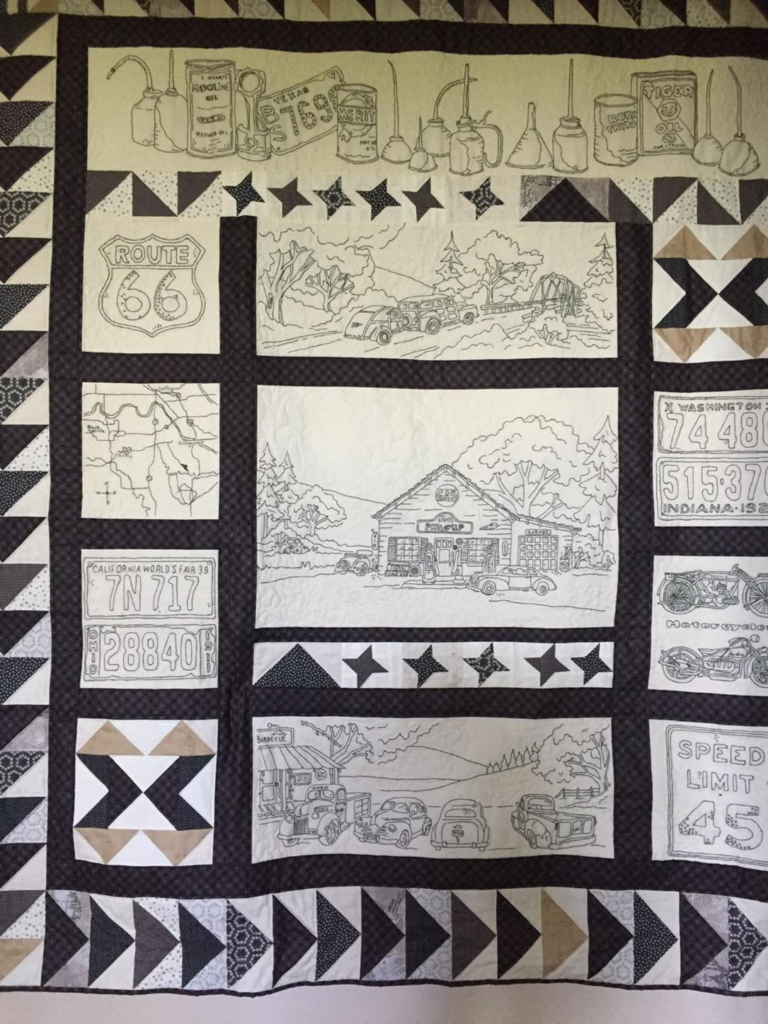
This pattern is called “Vintage Tin” and was hand embroidered and machine pieced by the owner.